- BOAT OF THE YEAR
- Newsletters
- Sailboat Reviews
- Boating Safety
- Sailing Totem
- Charter Resources
- Destinations
- Galley Recipes
- Living Aboard
- Sails and Rigging
- Maintenance


Refit a Classic Yacht with an Electric Windlass
- By David Schmidt
- March 16, 2022
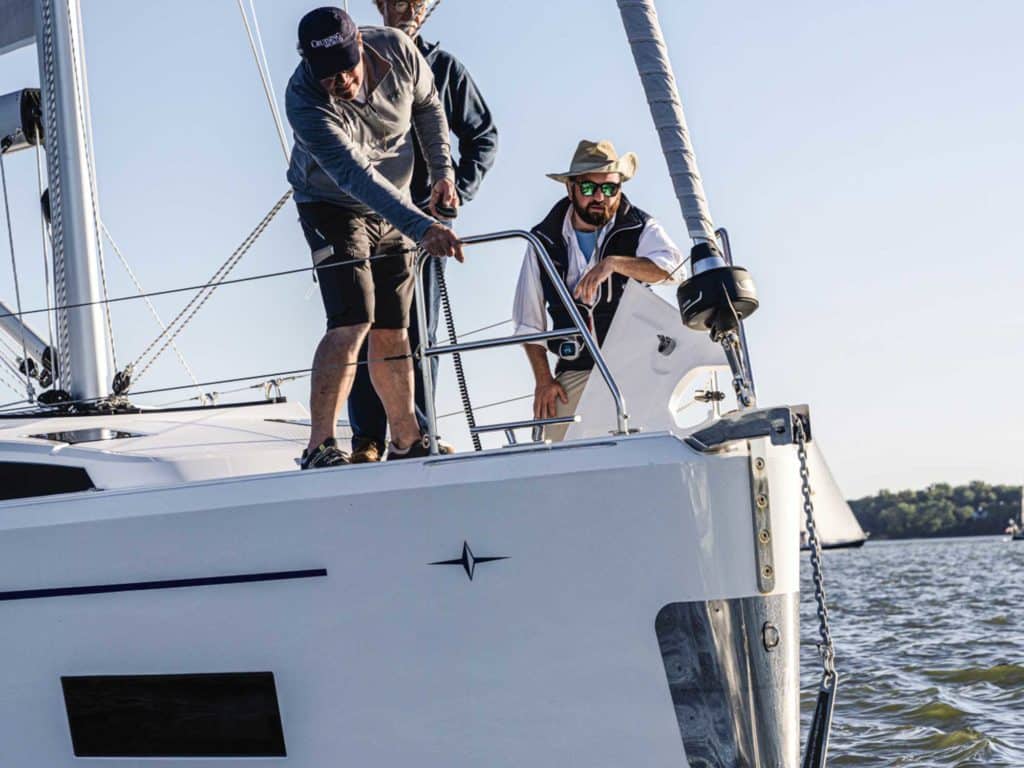
I still remember (robustly) arguing with my dad when he announced his plans to add a windlass to the J/44 he owned. He was thinking of easy anchoring. I was thinking of weight and the boat’s ability to hit its polars. I lost that fight, and I’ll admit to having some smoldering feelings—until we went cruising and I was charged with anchor retrieval. I reached down to start sweating in the 7-to-1 scope and the big Danforth anchor, until I saw the windlass foot switch. I remember pulling in the rode until it came vertical, waiting for my dad to break the anchor’s grip by nudging the boat forward with the engine, and then nonchalantly employing the switch, hoping he wouldn’t notice. No dice.
Bottom line: As a racing sailor, I wasn’t going to admit that the windlass was an upgrade, but there’s no question that it allowed my parents to enjoy years of additional cruising, while also saving me from back pain more than once.
The premise behind a windlass is simple: It employs power and mechanical advantage to make it easier to retrieve a vessel’s ground tackle and feed its rode into the anchor well. To do so, over time, windlass design evolved into two camps: horizontal and vertical, allowing boat owners or, more likely with new boats, the builders, to select equipment that best fits their particular yacht.
While high-quality windlasses are effective and dependable, a cost-cutting trend emerged in the 1970s and 1990s whereby boatbuilders offered windlasses as optional—not standard—equipment. As a result, many cruising boats were delivered sans windlasses. Flash-forward to the 2020s, and many of these boats are now changing hands. Their new owners, however, are less interested in footing chiropractic bills. Here’s a look at how a windlass works, the design and installation considerations involved, and the benefits it provides.
The Big Picture
A windlass functions as part of a larger system that includes the anchor, sometimes a swivel and chain, sometimes rope, some sort of a snubber or chain stopper, the anchor roller, the windlass itself, the anchor well, the windlass controls, and the windlass’s power supply. All of these individual pieces of equipment need to be correctly spec’d for the system to work properly.
“Start with what size anchor you’re going to use,” Harcourt Schutz advises. He is Lewmar’s senior director of aftermarket sales. He explains that the total weight of the boat’s ground tackle (not just the tackle that you expect to deploy) should represent one-quarter of the windlass’s working load. “It’s based on the anchor and rode, not the boat’s displacement. The anchor and rode are what you’re picking up. If you already have the rope and chain, match what’s there.”
If you’re starting from scratch, Fred Cook, president of Schaefer Marine, advises that not all chain is created equal. “I wish everybody would use high-test chain,” he says, adding that while this is more expensive than a standard galvanized marine alloy, it delivers considerably greater strength.
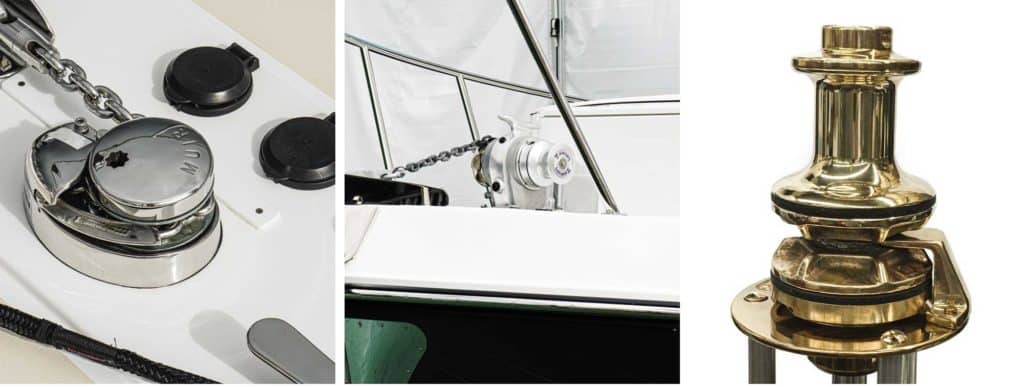
Cook says that the windlass’s chain wildcat, or gypsy (the coglike mechanism that controls the chain), must be spec’d to match the specific chain with which it will be paired. (Wildcat is the term typically used in the States; gypsy is preferred by Brits. To further confuse matters, in the US, an additional drum around which an anchor rope is wound is called the gypsy; the Brits call it a warping head.)
Wildcats typically are modular, and Cook suggests that cruisers mail a small section of chain to the windlass’s manufacturer (or distributor) to ensure that the chain wildcat’s web (that is, the teeth that engage the chain links) is properly matched.
While chain-and-rope rodes are common in North America, this isn’t the international norm. “No one uses rope except the US. Everyone else uses all-chain rodes,” says Jim Thomas, Imtra’s product manager for Lofrans and Muir anchoring products. He says rope-to-chain rodes evolved in the 1990s as a cost-cutting measure. These setups are rigged with the chain attached directly to the anchor on one end and spliced to rope (typically three-strand) on the other. While this setup reduces bow weight (“aah,” the racing sailor says), anyone who might eventually want an all-chain rode should consider this when spec’ing their windlass.
Swivels are sometimes situated between the chain’s last link and the anchor. Thomas notes that swivels are helpful in removing twists from the anchor rode during recovery. Meanwhile, if the anchor-roller wheel has a notch or a groove, this helps in aligning the links for entry into the gypsy, he adds. And the swivel’s articulation helps align the chain as the anchor is pulled onto the roller. Additionally, swivels can help a set anchor negotiate windshifts and rising and falling tides, but Thomas and Schutz are both quick to point out that each additional proverbial link in the chain could be a point of failure. Because of this, both experts encouraged customers to use only high-quality swivels.
Any boat that’s equipped for anchoring with a windlass should have a bow-mounted anchor roller, which safely contains the anchor on deck and helps keep the rode in line with the windlass. As mentioned, it’s important to ensure that the roller’s shape matches the profile of your anchor chain.
There’s still more to note when it comes to assessing a vessel’s anchoring system. “Anchor lockers are unfriendly environments,” Schutz says of the belowdecks space where the rode is stowed. “They’re oversaturated with salt air.” This is a result of the inevitable water and harbor mud that windlasses raise along with the hook. The rub is that anchor wells usually contain the windlass’s power cables and, depending on the design of the windlass, its gear box. As a result, experts suggest that cruisers employ a bow hose or shower to rinse the rode as it’s hoisted, and to give the windlass, the anchor, and its rode freshwater rinses when possible.
Up and Down or Sideways
As mentioned, there are two common windlass designs: horizontal and vertical. While both retrieve anchor gear, the drive shaft on horizontal windlasses is horizontal, while vertical windlasses employ vertical drive shafts. This means that the chain wildcat on a horizontal windlass spins like a Ferris wheel, while the chain gypsy on a vertical windlass turns like a merry-go-round.
“Horizontal windlasses don’t have as much contact with the chain,” Thomas says, adding that the wildcat on a horizontal windlass typically has 110 degrees of chain contact. Conversely, “a vertical windlass has 270 degrees of surface contact. Vertical windlasses are better with rope-and-chain rodes, while horizontal windlasses are better-suited for all-chain rodes.”
Because of their fixed-volume nature, anchor wells often dictate how much rode one can carry, and they can influence one’s purchase decisions. “The distance between the windlass to the top of the line stack in the locker matters,” Schutz advises, adding that horizontal windlasses work best if this distance is at least a foot, while vertical designs work best when there’s 12 to 18 inches separating the windlass from the top of the line stack.
The other major design difference involves how much of the windlass is situated abovedecks. Horizontal windlasses are typically entirely deck-mounted. This frees up bow-locker space, but they occupy more deck real estate than vertical windlasses, which typically employ a belowdecks gear box. While Thomas advises that deck thickness can sometimes steer purchase decisions, given that most vertical windlasses use drive shafts that top out at 5 inches, Cook points out that custom shaft lengths can usually be accommodated. That said, unless you sail a wooden classic, odds are good that your fiberglass deck is only an inch or two thick.
Besides their design orientation, there are a variety of ways to control their operation. One common way is to employ deck-mounted foot switches, with one pedal lowering the rode and the other reversing the direction of the wildcat to retrieve it. Manufacturers also offer handheld controllers, wireless key-fob-like controls and even helm-mounted controls.
Lowering an anchor and its rode is fairly straightforward. Some cruisers install chain or rope counters in the system to help quantify the amount of deployed scope. Others paint the chain and rode at regular intervals or use a variety of plastic or cloth markers. It’s worth noting that at present, windlasses still employ solenoids to control the direction in which the wildcat turns. This means that windlasses have yet to become NMEA 2000 compatible, and therefore they currently cannot be controlled via the vessel’s chart plotter, a networked smartphone, or a digital-switching system. However, the experts interviewed for this story suggest that NMEA compatibility is coming in the next year or two.
Put It to Use
Once the anchor is set and the scope properly adjusted, experts suggest transferring the load off the windlass’s gear box and onto independent hardware. If you’re running a chain-to-rope rode, the easy solution if all of the chain is out is to tie the rope to a bow cleat. If you’re using an all-chain rode, manufacturers offer various hooks and/or snubbers that attach to a cleat and to a link in the chain, thus transferring the load off the windlass. As an aside, most modern catamarans come with a bridle arrangement that’s been pre-installed and which keeps the rode centered between the two hulls.
One of the smartest things anyone told me about sailhandling involves constantly looking at the sail or running rigging that’s affected when jumping a halyard or spinning a winch to ensure that something isn’t accidentally overloaded. Windlasses are no different. All experts agree that it’s wise to station one crewmember at the bow and another at the helm for anchor-retrieval work. They all also strongly recommend keeping the engine in gear (low RPM) and using it to drive the boat toward the anchor, with the forward crew either manually sweating in the rode or using the windlass. Once the rode is taut and near-vertical, it’s best to use the engine—not the windlass—to break the anchor’s grip on the seafloor. Once the hook is free, the crew can reengage the windlass, keeping a constant eye on things to ensure that the anchor roller or bow section isn’t damaged by overstraining the system once the anchor is on board.
If used properly, windlasses can greatly simplify anchor retrieval, but it goes without saying, just as with any high-torque system, it’s critical to pay attention and keep one’s hands clear of lines and moving parts.
As with all electrical systems, windlasses require DC juice. In a retrofit, this means an owner will typically have to run two, or possibly three, heavy-gauge cables forward to the bow from the house batteries. If you have a bow thruster installed that’s serviced by a local battery, this well of DC power can service the windlass too. The experts stressed the importance of situating a suitably sized windlass breaker as close to the battery as possible. “The circuit breaker protects the wires and the windlass motor,” Thomas says, advising that it’s wise to use thermal breakers.
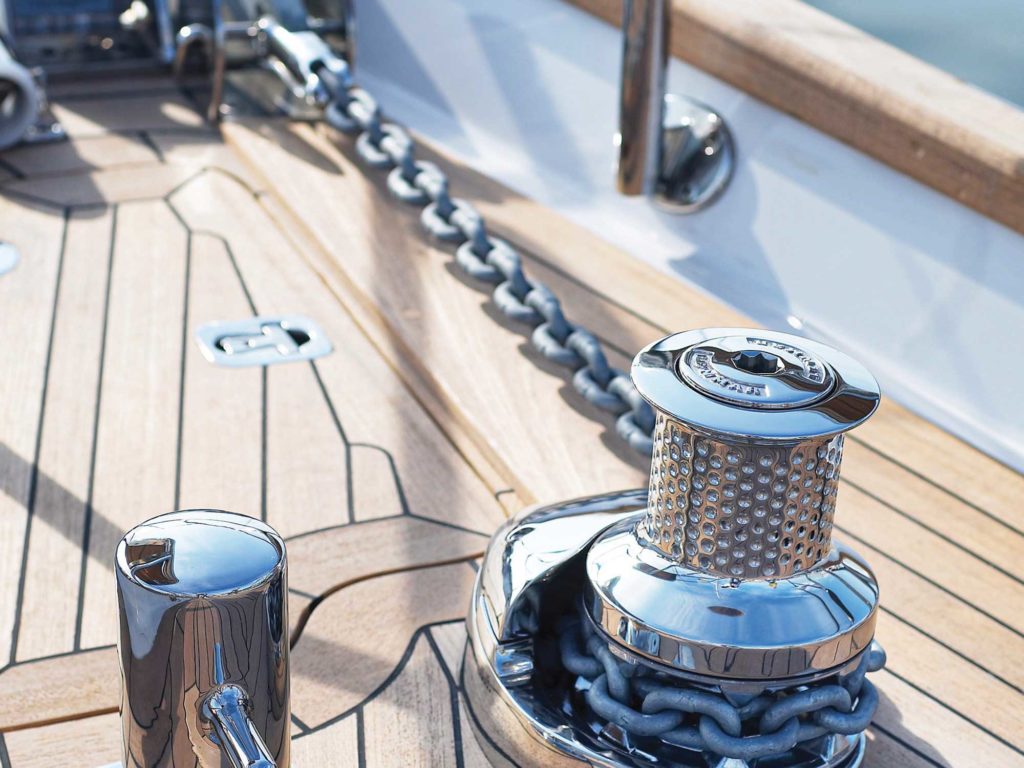
Given that boatyards typically require two days of labor to install a windlass aboard a 40-footer, it’s tempting for do-it-yourselfers to tackle a windlass refit on their own. “It’s pretty straightforward, but you need to be comfortable cutting holes in fiberglass,” Schutz says, adding that vertical windlasses usually necessitate larger apertures. “It’s not super easy, but if you’re comfortable with power tools, it’s not a deal-breaker. Running the wires is the hardest part.”
Maintenance is the last major consideration. Aside from keeping the rode clean and occasionally rinsing it with fresh water, it’s important to use your windlass several times per season (more is better) to ensure that the lubricating oil inside the windlass’s case is evenly distributed along its internal worm drive. “The worm gear is set in oil halfway,” Cook says. “The worm gear can rust out above the oil” if it’s not regularly used. Cook also suggested periodically checking your windlass’s seals to ensure that water isn’t entering the casing and affecting internal oil levels. Schutz recommends that owners with vertical windlasses keep the belowdecks componentry properly painted to avoid rust or corrosion—in other words, touch up nicks and dings. Thomas also recommends keeping the system’s clutch cones clean and greased.
Provided that users apply proper care and maintenance, a modern windlass should provide years of great service. And while there’s no escaping the added bow weight, this matters only if you’re more interested in winning pickle dishes than enjoying peaceful nights in beautiful locales with your friends and family.
David Schmidt is CW ’s electronics editor and occasionally writes on other gear topics.
Vendor List
Bainbridge distributes Italwinch: bainbridgeintusa.com/italwinch from $1,060.
Imtra offers windlasses from Muir and Lofrans: imtra.com ; from $1,200.
Lewmar: lewmar.com from $1,000.
Vetus distributes Maxwell windlasses: vetus-maxwell.com from $2,210.
Quick Spa: quickitaly.com from $1,500.
Schaefer Marine carries the Ideal windlass brand: schaefermarine.com from $4,000.
- More: Anchoring , Gear , print 2022 march , refit , Windlass
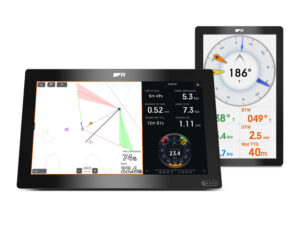
Raymarine Announces Sailing Package Giveaway
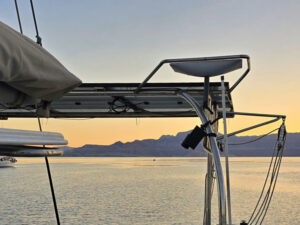
Welcome Aboard, Starlink
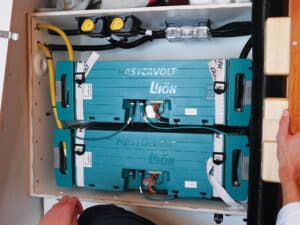
Generators Not Included
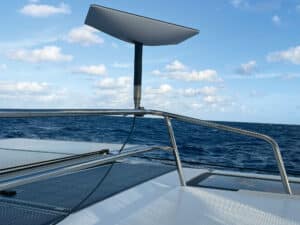
The Days of Dishy McFlatface Have Arrived

Sail On, Sally
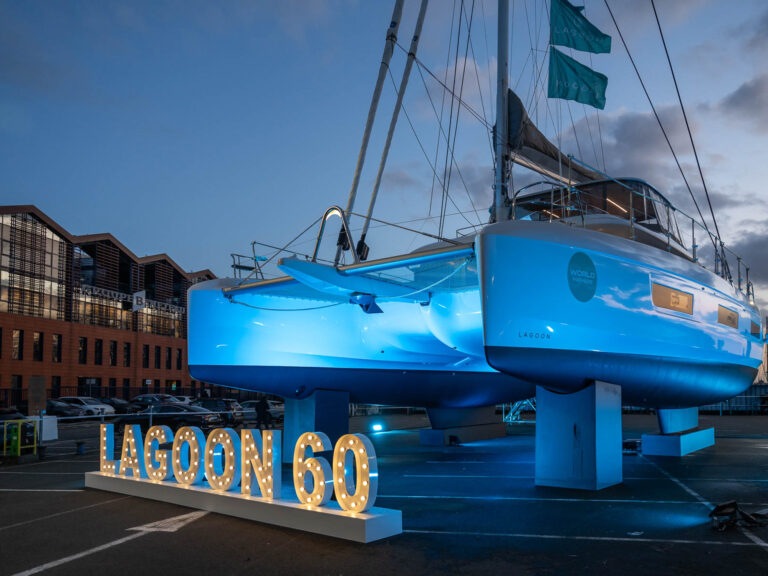
Lagoon 60 Prepares for World Premiere
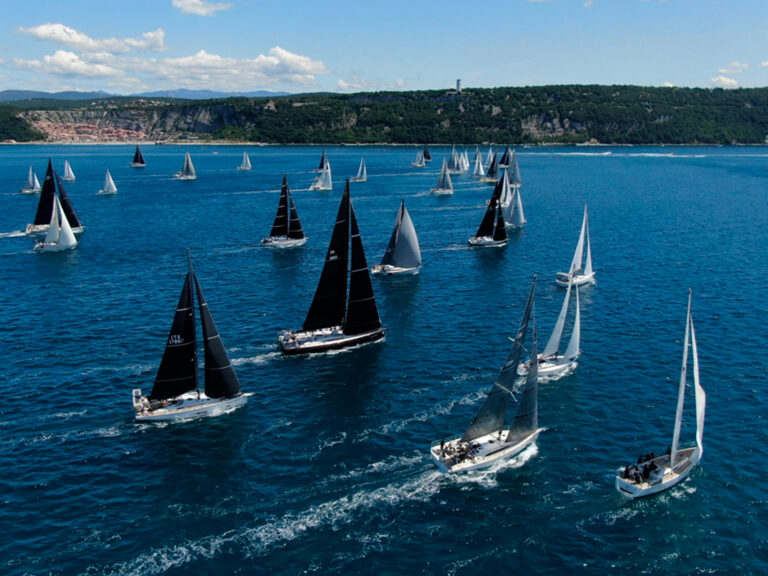
Grand Soleil Cup Gearing Up
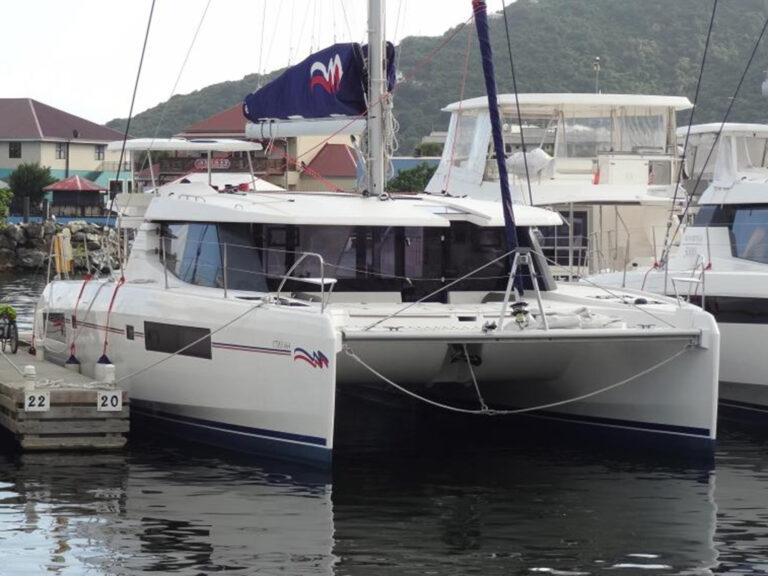
Now For Sale: Leopard 45
- Digital Edition
- Customer Service
- Privacy Policy
- Email Newsletters
- Cruising World
- Sailing World
- Salt Water Sportsman
- Sport Fishing
- Wakeboarding
- 2024 BOAT BUYERS GUIDE
- Email Newsletters
- Boat of the Year
- 2024 Freshwater Boat and Gear Buyers Guide
- 2024 Boat Buyers Guide
- 2024 Water Sports Boat Buyers Guide
- 2024 Pontoon Boat Buyers Guide
- Cruising Boats
- Pontoon Boats
- Fishing Boats
- Personal Watercraft
- Water Sports
- Boat Walkthroughs
- What To Look For
- Watersports Favorites Spring 2022
- Boating Lab
- Boating Safety

How to Install an Electric Windlass
- By Jim Hendricks
- Updated: August 23, 2017
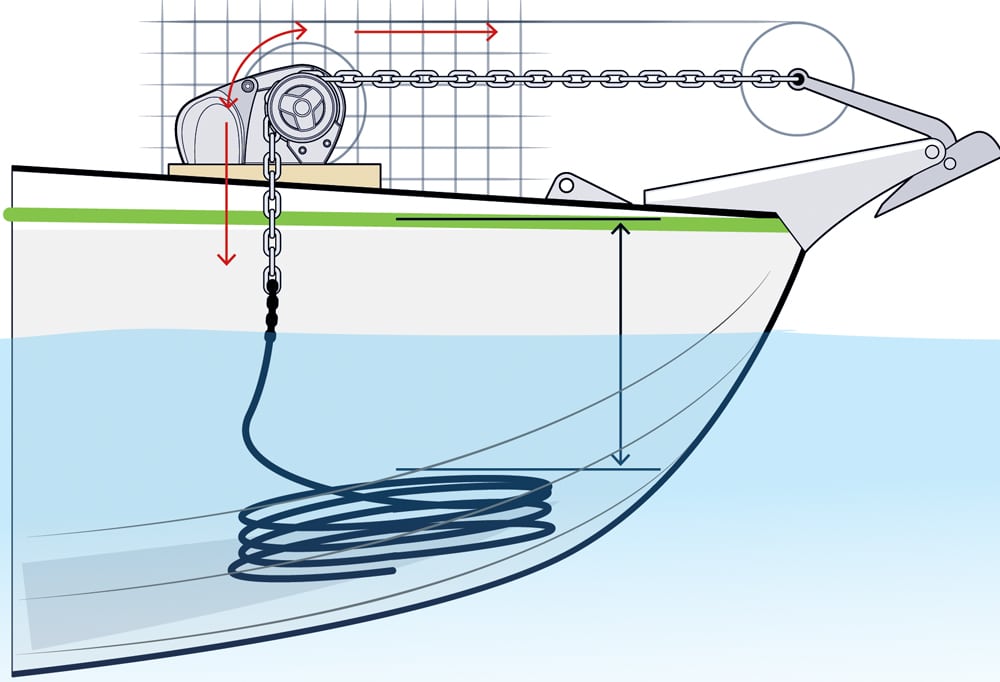
There are two types of electric anchor windlasses: horizontal-gypsy models with the unit fully enclosed above deck and vertical-gypsy models with much of the unit concealed below deck.
Both automaticaly feed line and chain into the rode locker. We chose the Pro-Fish 1000 horizontal windlass from Lewmar ( lewmar.com ), which has a free-fall function. This feature lets you drop anchor quickly, allowing more precise anchoring than slower “power-out” models, but requires a deeper rode locker to prevent tangles. It is suitable for boats to 38 feet in length.
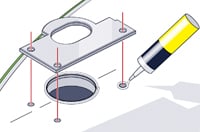
1. Mounting of the Windlass Select a mounting location on the bow that allows the rode to drop directly into the anchor locker and also puts the gypsy in a straight line with the anchor roller. The minimum anchor-locker depth is 12 inches to the top of the rode pile. Use the supplied template to cut the holes to feed the rode into the locker and to accommodate the wires and the three supplied mounting studs. If the deck is not flat, create fairing blocks for both the top and underside of the deck. Also consider a backing plate made of aluminum or plywood. Secure the studs inside the windlass with Loctite. A rubber gasket seal fits between the windlass and the mounting surface.
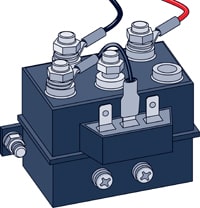
2. Up/Down Contactor Installation We ordered an optional up/down contactor (part 68000939) that allows for multiple control switches and relays 12-volt power from the battery to the windlass. This allows control from the helm and from on the bow. The contactor needs to be installed vertically in a dry area. We through-bolted ours to a bulkhead in the bow and connected the wires from the windlass to the output studs on the contactor.
Quick tip: To resist corrosion, use tinned-copper marine wire and marine-grade connectors with heat-shrink nylon sleeves. Also, enclose all connections with heat-shrink tubing.
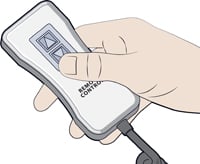
3. Bow Switch There are a number of optional bow switches, but we chose a hard-wired, waterproof, hand-held control (part 68000599) with a coiled electrical cord. When not in use, it can be snapped into a vertical bracket (which we mounted inside the anchor locker) or unplugged and stowed. We wired it to switching posts on the contactor.
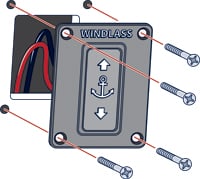
4. Helm Switch The Pro-Fish 1000 comes with an up/down rocker switch. Using the supplied template, we cut a rectangular mounting hole near the helm and drilled four holes for the supplied screws to install the switch. We then extended its two size 14 American wire gauge (AWG) wires and snaked them forward to connect to switching studs on the contactor.
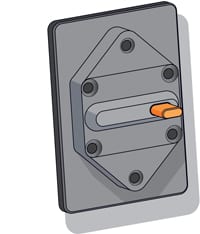
5. Power Delivery A windlass requires heavy-gauge cable from the battery to the contactor. Lewmar provides charts to determine cable size. Our run of 25 feet called for size 4 AWG cable for both the positive and negative feeds. For circuit protection, the positive cable must be fed through a supplied 70-amp breaker switch, which also allows you to shut off power to the windlass.
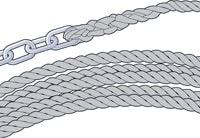
6. The Right Rode The gypsy on the Pro-Fish 1000 is designed to fit 9/16-inch three-strand or eight-plait line and 5/16-inch G4 chain. To function properly, it also requires a rope-to-chain splice. You can buy a pre-made windlass rode ($284.99 for 200 feet, westmarine.com).
For more on horizontal versus vertical windlasses, visit boatingmag.com/windlass .
- More: diy projects , How-To , Weekend Workbook
More How To

On Board With: Brian Grubb
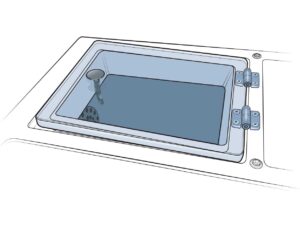
Installing Clear Acrylic Livewell Lids

Captain of Dive Boat That Caught Fire Sentenced to Four Years
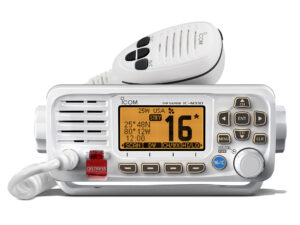
How to Make DSC Fully Functional on a VHF Radio
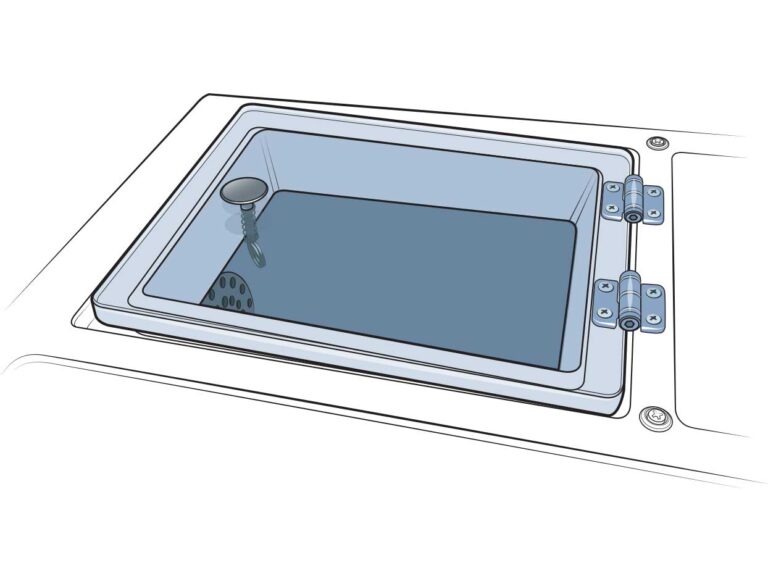
Boat Test: 2024 Solara S-250 DC
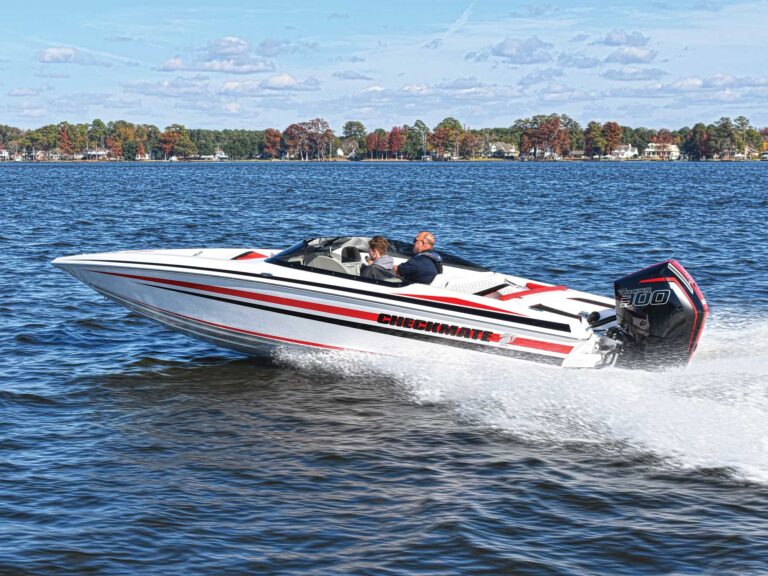
Boat Test: 2024 Checkmate Pulsare 2400 BRX
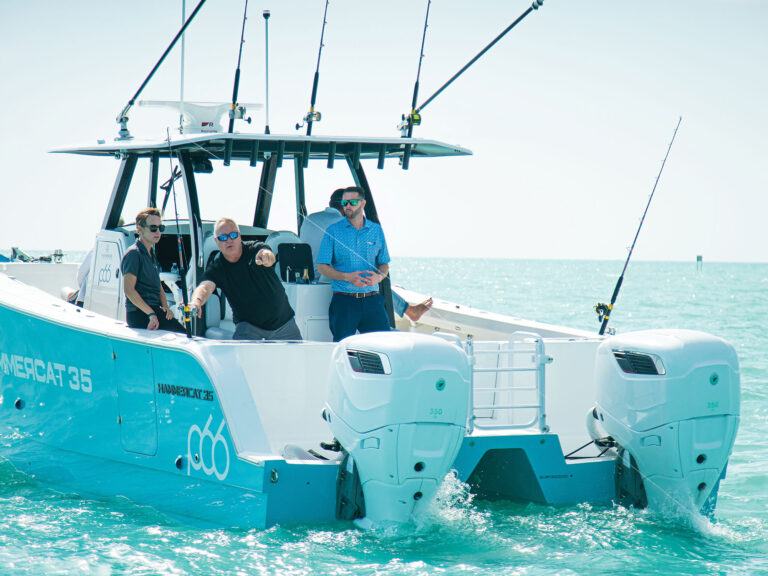
Cox 350 Diesel Outboard

- Digital Edition
- Customer Service
- Privacy Policy
- Cruising World
- Sailing World
- Salt Water Sportsman
- Sport Fishing
- Wakeboarding
Many products featured on this site were editorially chosen. Boating may receive financial compensation for products purchased through this site.
Copyright © 2024 Boating Firecrown . All rights reserved. Reproduction in whole or in part without permission is prohibited.

Currency: GBP
- Worldwide Delivery
Mooring Warps and Mooring Lines
- LIROS 3 Strand Polyester Mooring Warps
- LIROS Green Wave 3 Strand Mooring Warps
- LIROS Braided Dockline Mooring Warps
- LIROS Handy Elastic Mooring Warps
- Marlow Blue Ocean Dockline
- LIROS Super Yacht Mooring Polyester Docklines
- 50 metre / 100 metre Rates - Mooring
Mooring Accessories
- Mooring Compensators
Mooring Strops and Bridles
- V shape Mooring Bridles
- Y shape Mooring Bridles
- Small Boat and RIB Mooring Strops
- Mooring Strops
- Mooring Strops with Chain Centre Section
Mooring Assistance
- Coastline Bow Thruster Accessories
- Max Power Bow Thrusters
- Bonomi Mooring Cleats
- Majoni Fenders
- Polyform Norway Fenders
- Ocean Inflatable Fenders
- Dock Fenders
- Fender Ropes and Accessories
Mooring Components
- Mooring Swivels
- Mooring Shackles
- Mooring Cleats and Fairleads
- Mooring Buoys
Mooring Information
- Mooring Warps Size Guide
- Mooring Lines - LIROS Recommended Diameters
- Mooring Rope Selection Guide
- Mooring Warp Length and Configuration Guide
- How to estimate the length of a single line Mooring Strop
- Mooring Ropes - Break Load Chart
- Mooring Compensator Advisory
- Rope Cockling Information
- Fender Size Guide
- Majoni Fender Guide
- Polyform Norway Fender Inflation Guide
Custom Build Instructions
- More Article and Guides >
Anchor Warps Spliced to Chain
- LIROS 3 Strand Nylon Spliced to Chain
- LIROS Anchorplait Nylon Spliced to Chain
Anchor Warps
- 50 / 100 metre Rates - Anchoring
- Drogue Warps and Bridles
- Leaded Anchor Warp
- LIROS 3 Strand Nylon Anchor Warps
- LIROS Anchorplait Nylon Anchor Warps
- Aluminium Anchors
- Galvanised Anchors
- Stainless Steel Anchors
Calibrated Anchor Chain
- Cromox G6 Stainless Steel Chain
- G4 Calibrated Stainless Steel Anchor Chain
- Lofrans Grade 40
- MF DAMS Grade 70
- MF Grade 40
- Titan Grade 43
- Lewmar Windlasses
- Lofrans Windlasses
- Maxwell Windlasses
- Quick Windlasses
- Windlass Accessories and Spares
Chain Snubbers
- Chain Hooks, Grabs and Grippers
- Chain Snubbing Bridles
- Chain Snubbing Strops
Anchoring Accessories
- Anchor Connectors
- Anchor Trip Hooks and Rings
- Anchoring Shackles
- Bow Rollers and Fittings
- Chain and Anchor Stoppers
- Chain Links and Markers
Anchoring Information
- How To Choose A Main Anchor
- Anchoring System Assessment
- Anchor Chain and Rope Size Guide
- The Jimmy Green Guide to the Best Anchor Ropes
- What Size Anchor Do I Need?
- Anchor Size Guides
- Anchor Rope Break Load and Chain Compatibility Chart
- How to Choose Your Anchor Chain
- How to Establish the Correct Anchor Chain Calibration?
- Calibrated Anchor Chain - General Information
- Calibrated Anchor Chain Quality Control
- Calibrated Chain - Break Load and Weight Guide
- Galvanising - Managing Performance and Endurance expectation
- Can Galvanised Steel be used with Stainless Steel?
- Windlass Selection Guide
- More Articles and Guides
Stainless Steel Wire Rigging and Wire Rope
- 1x19 Wire Rigging
- 50 / 100 metre Rates - Wire and Fibre
- 7x19 Flexible Wire Rigging
- Compacted Strand Wire Rigging
Dinghy Rigging
- Dinghy Rigging Fittings
- Fibre Dinghy Rigging
- Stainless Steel Dinghy Rigging
- Wind Indicators
Fibre Rigging
- DynIce Dux Fibre Rigging
- LIROS D-Pro Static Rigging
- LIROS D-Pro-XTR Fibre Rigging
- Marlow Excel D12 MAX 78 Rigging
- Marlow M-Rig Max Rigging
Wire Terminals
- Cones, Formers, Wedges, Ferrules, Rigging Spares
- Hi-Mod Swageless Terminals
- Sta-Lok Swageless Terminals
- Swage Terminals
- Headsail Reefing Furlers
- Plastimo Jib Reefing
- Selden Furlex Reefing Gear
Furling Systems
- Anti-torsion Stays
- Straight Luff Furlers
- Top Down Furlers
Guard Wires, Rails and Fittings
- Guard Rail Fittings
- Guard Rails in Fibre and Webbing
- Guard Wire Accessories
- Guard Wires
Wire Rigging Fittings
- Babystay and Backstay Adjustment
- Terminal Backing Plates and Coquilles
- Turnbuckles and Rigging Screws
Rigging Accessories
- Rigging Chafe Protection
Standing Rigging Assistance
- More Articles and Guides >
- Cruising Halyards
- Performance Halyards
- Dinghy Halyards
Rigging Shackles
- Captive and Key Pin Shackles
- hamma™ Snap Shackles
- Soft Shackles
- Standard Snap Shackles
- Wichard Snap Shackles
Classic Ropes
- Classic Control Lines
- Classic Halyards
- Classic Sheets
- Cruising Sheets
- Performance Sheets
- Dinghy Sheets
Sail Handling
- Boom Brakes and Preventers
- Lazy Jack Sail Handling
- Rodkickers, Boomstruts
- Sail Handling Accessories
50 / 100 metre Rates - Running Rigging
- 50 / 100 metres - Cruising Ropes
- 50 / 100 metres - Dinghy Ropes
- 50 / 100 metres - Performance Ropes
Control Lines
- Cruising Control Lines
- Performance Control Lines
- Dinghy Control Lines
- Continuous Control Lines
Running Rigging Accessories
- Anti-Chafe Rope Protection
- Lashing, Lacing and Lanyards
- Mast and Boom Fittings
- Rope Stowage
- Sail Ties and Sail Stowage
- Shock Cord and Fittings
- LIROS Ropes
- Marlow Ropes
Running Rigging Resources
- Running Rigging Rope Fibres and Construction Explained
- How to Select a Suitable Halyard Rope
- How to select Sheets and Guys
- Dyneema Rope - Cruising and Racing Comparison
- Dinghy Rope Selection Guide
- Rope Measurement Information
- Running Rigging - LIROS Recommended Line Diameters
- Running Rigging Break Load Comparison Chart
- Colour Coding for Running Rigging
- Selecting the right type of block, plain, roller or ball bearing
- Replacing your Furling Line
- Recycling Rope
- Running Rigging Glossary
Custom Build Instructions for Sheets, Halyards, Control Lines
Plain bearing blocks.
- Barton Blocks
- Harken Element Blocks
- Low Friction Rings
- Selden Yacht Blocks
- Wichard MXEvo Blocks
- Wooden Yacht Blocks
Control Systems
- Ratchet Blocks
- Stanchion Blocks and Fairleads
- Snatch Blocks
- Genoa Car Systems
- Traveller Systems
- Block and Tackle Purchase Systems
Ball Bearing Blocks
- Harken Ball Bearing Blocks
- Selden Ball Bearing Blocks
Roller Bearing Blocks
- Harken Black Magic Blocks
- Selden Roller Bearing Blocks
Deck Fittings
- Bungs and Hatches
- Bushes and Fairleads
- Deck Eyes, Straps and Hooks
- Pad Eyes, U Bolts and Eye Bolts
- Pintles and Gudgeons
- Tiller Extensions and Joints
- Harken Winches, Handles and Accessories
- Barton Winches, Snubbers and Winchers
- Lewmar Winches, Handles and Accessories
- Winch Servicing and Accessories
Clutches and Organisers
- Barton Clutches and Organisers
- Spinlock Clutches and Organisers
- Lewmar Clutches
- Harken Ball Bearing Cam Cleats
- Barton K Cam Cleats
Deck Hardware Support
- Blocks and Pulleys Selection Guide
- Barton High Load Eyes
- Dyneema Low Friction Rings Comparison
- Seldén Block Selection Guide
- Barton Track Selection Guide
- Barton Traveller Systems Selection Guide
- Harken Winch Selection Guide
- Karver Winch Comparison Chart
- Lewmar Winch Selection Guide - PDF
- Winch Servicing Guide
Sailing Flags
- Courtesy Flags
- Red Ensigns
- Blue Ensigns
- Signal Code Flags
- Flag Staffs and Sockets
- Flag Accessories
- Flag Making and Repair
- Webbing only
- Webbing Soft Shackles
- Webbing Restraint Straps
- Webbing Sail Ties
- Sail Sewing
- PROtect Tape
Fixings and Fastenings
- Screws, Bolts, Nuts and Washers
- Monel Rivets
Hatches and Portlights
- Lewmar Hatches
- Lewmar Portlights
- Fids and Tools
- Knives and Scissors
General Chandlery
- Carabiners and Hooks
- Antifouling
Chandlery Information
Flag articles.
- Flag Size Guide
- Bending and Hoisting Methods for Sailing Flags
- Courtesy Flags Identification, Labelling and Stowage
- Courtesy Flag Map
- Flag Etiquette and Information
- Glossary of Flag Terms and Parts of a Flag
- Making and Repairing Flags
- Signal Code Message Definitions
Other Chandlery Articles
- Anchorplait Splicing Instructions
- Antifoul Coverage Information
- Hawk Wind Indicator Selection Guide
- Petersen Stainless - Upset Forging Information
- Speedy Stitcher Sewing Instructions
- Thimble Dimensions and Compatible Shackles
Jackstays and Jacklines
- Webbing Jackstays
- Stainless Steel Wire Jackstay Lifelines
- Fibre Jackstay Lifelines
- Jackstay and Lifeline Accessories
Lifejackets
- Children's Life Jackets
- Crewsaver Lifejackets
- Seago Lifejackets
- Spinlock Lifejackets
Floating Rope
- LIROS Multifilament White Polypropylene
- LIROS Yellow Floating Safety Rope
Guard Wires, Guardrails and Guardrail Webbing
Lifejacket accessories.
- Lifejacket Lights
- Lifejacket Rearming Kits
- Lifejacket Spray Hoods
- Safety Lines
Seago Liferafts
- Grab Bag Contents
- Grab Bags and Polybottles
- Liferaft Accessories
- Danbuoy Accessories
- Jimmy Green Danbuoys
- Jonbuoy Danbuoys
- Seago Danbuoys
Overboard Recovery
- Lifebuoy Accessories
- Purchase Systems
- Slings and Throwlines
Safety Accessories
- Fire Safety
- Sea Anchors and Drogues
Safety Resources
- Guard Wires - Inspection and Replacement Guidance
- Guard Wire Stud Terminal Dimensions
- Webbing Jackstays Guidance
- Webbing Jackstays - Custom Build Instructions
- Danbuoy Selection Guide
- Danbuoy Instructions - 3 piece Telescopic - Offshore
- Liferaft Selection Guide
- Liferaft Servicing
- Man Overboard Equipment - World Sailing Compliance
- Marine Safety Information Links
- Safety Marine Equipment List for UK Pleasure Vessels
Sailing Clothing
- Sailing Jackets
- Sailing Trousers
- Thermal Layers
Leisure Wear
- Accessories
- Rain Jackets
- Sweatshirts
Sailing Footwear
- Dinghy Boots and Shoes
- Sailing Wellies
Leisure Footwear
- Walking Shoes
Sailing Accessories
- Sailing Bags and Holdalls
- Sailing Gloves
- Sailing Kneepads
Clothing Clearance
Clothing guide.
- What to wear Sailing
- Helly Hansen Mens Jacket and Pant Size Guide
- Helly Hansen Womens Sailing Jacket and Pant Size Guide
- Lazy Jacks Mens and Womens Size Charts
- Musto Men's and Women's Size Charts
- Old Guys Rule Size Guide
- Sailing Gloves Size Guides
- Weird Fish Clothing Size Charts
The Jimmy Green Clothing Store
Lower Fore St, Beer, East Devon, EX12 3EG
- Adria Bandiere
- Anchor Marine
- Anchor Right
- August Race
- Barton Marine
- Blue Performance
- Brierley Lifting
- Brook International
- Brookes & Adams
- Captain Currey
- Chaineries Limousines
- Coastline Technology
- Colligo Marine
- Cyclops Marine
- Douglas Marine
- Ecoworks Marine
- Exposure OLAS
- Fire Safety Stick
- Fortress Marine Anchors
- Hawk Marine Products
- Helly Hansen
- International
- Jimmy Green Marine
- Maillon Rapide
- Mantus Marine
- Marling Leek
- Meridian Zero
- MF Catenificio
- Ocean Fenders
- Ocean Safety
- Old Guys Rule
- Petersen Stainless
- Polyform Norway
- PSP Marine Tape
- Sidermarine
- Stewart Manufacturing Inc
- Team McLube
- Technical Marine Supplies
- Titan Marine (CMP)
- Ultramarine
- Waterline Design
- William Hackett
Clearance August Race Boat Cleaning Kit £26.00
Clearance LIROS Racer Dyneema £55.08
Clearance Folding Stock Anchor £123.25
Clearance LIROS Herkules £0.00
Clearance Barton Size 0 Ball Bearing Blocks - 5mm £10.13
Clearance Marlow Blue Ocean® Doublebraid £18.48
Mooring Clearance
Anchoring clearance, standing rigging clearance, running rigging clearance, deck hardware clearance, chandlery clearance, safety clearance.
Electric Windlasses for anchoring are standard equipment for most new sailing yachts and motorboats.
Upgrades on older yachts are increasingly popular with the advent of improved DC electric charging systems and the tendency towards longer lengths of anchor chain.
The Jimmy Green Team can advise you on all the options regarding your anchoring system, whether you are looking for a suitable matching component to replace a part of the existing setup or starting afresh.
Team Jimmy Green can help you match a new or replacement windlass to your existing chain and anchor, advising you on all aspects of the selection process, including the calibration of the gypsy and all the accessories required to finish the installation.
Team Jimmy Green can also provide you with all the necessary information to determine the optimum new windlass, including suggestions for your corresponding anchor rode setup, i.e. chain, warp, combinations, connectors, shackles and anchors.
Select from four top-quality windlass manufacturers: Lofrans, Lewmar, Maxwell and Quick. Each brand also has a wide range of Windlass Accessories, including Chain Counters, Foot Switches, Control Boxes, Circuit Breakers, Remote Controls, Handles, Maintenance Kits and Spare Parts.
The Windlass Selection Guide provides more information about windlass selection criteria, and you will find more specific information for each manufacturer in their category below.
Boat Length (Windlasses)
- up to 20 feet (18) up to 25 feet (33) up to 30 feet (26) up to 35 feet (29) up to 40 feet (30) up to 45 feet (21) up to 50 feet (11) up to 55 feet (7) up to 60 feet (10) up to 65 feet (8) up to 70 feet (6) up to 75 feet (6) up to 80 feet (3) up to 85 feet (3) up to 90 feet (4) up to 100 feet (2) up to 120 feet (2)
Horizontal or Vertical
- Horizontal (18) Vertical (36)
- 6mm (30) 7mm (6) 8.7mm (5/16 US Specification) (1) 8mm (33) 10mm (26) 12mm (11) 13mm (4) 14mm (4)
Accessories and Spares
- Chain Counter (8) Chain Pipe (1) Chain Stopper (1) Circuit Breaker (4) Control Box (4) Conversion Kit (1) Foot Switch (9) Handle (1) Maintentance Kit (4) Motor (3) Remote Control (15) Spare Parts (23) Switch (6)

Lofrans X2 Vertical Windlass
Quick prince dp2 vertical windlass, lofrans x1 vertical windlass.

Lewmar VX2+ Vertical Windlass
Lofrans kobra horizontal windlass, lofrans royal manual horizontal windlass, lofrans dorado horizontal windlass, lofrans x3 vertical windlass, lofrans falkon horizontal windlass, lofrans cayman horizontal windlass, lofrans tigres horizontal windlass, lewmar v700 vertical windlass.
KE+ Electronic Engine Controls: Prices are Low – Don't be Slow!

- Anchoring Windlasses
- Lofrans' Windlasses
- Lofrans Vertical Electric Windlass
Lofrans Project 1000 Low Profile 12V - Vertical Electric Windlass LW7921LP
Write a review.

- Create New Wish List
Description
Warranty information, lofrans project 1000 vertical windlass - low profile - 12v motor 1000w electric anchor windlass lw7921lp.
The Lofrans Project 1000 series boat windlasses are engineered to endure any marine environment a yacht or sailboat may traverse. Each part is manufactured with importance placed on light weight, high mechanical strength, and corrosion proof materials that are not only highly durable but also encompasses a sleek chrome finish that would look great on any boat foredeck.
- The Lofrans Project electric windlasses makes even the most difficult anchoring easier and safer by delivering immediate lifting power and deployment speed.
- The Lofrans 1000 windlass has the capability of being operated as a manual anchor winch. Electrical problems may arise due to any number of reasons, a manual override ensures a peace of mind. Use the supplied Lofrans manual over-ride/ clutch handle to hand crank your anchor and anchor chain/rope on-board in an emergency.
- Bronze base and drum - Mirror-like luxury chromed
- Purpose built watertight stainless steel ball bearing in the base
- In either a capstan or low profile design
- Manual Chain Release - Easy to use
- Manual Override - in case of electrical failure
- Rope chain management by the spring loaded arm
- Chain counter magnet factory installed
- Heavy duty two speed built in solenoids IP67 rate electric motor
- Black anodized aluminum gearbox - marine grade
- Control box built in
Primary Applications:
- Boats ranging from 23 feet to 46 feet
- A low profile winch is needed
What Comes In The Box:
- Windlass pre-assembled
- Manual over-ride clutch handle
- Neoprene deck gasket
- Watertight Control Box
- Two Heavy-duty foot switches
- Rope/Chain Gypsy (You Must Specify when ordering what size chain you have)
Specifications:
Extra deck clearance:.
There are two options for deck thickness:
- LWPDB003: Extends max clearance to 2-3/4"
- LW7921XDC: Extends max clearance to 5"
Downloads and Resources:
- Click here to view the Project 1000 Low Profile LW7921LP Owners Manual
- Click here to view Lofrans' Chainwheel Chart
- Click here to view the LW7921LP Parts Breakdown
- Click here to view the Project 1000 Low Profile Dimensional Drawing
- Click here to view the 3 Terminal Wiring Diagram
- Click here to view the Lofrans Gearbox Oil Capacity Guide
- Click here to view the Lofrans Master Parts List
- Click here to view Imtra's Anchoring Windlasses Catalog
- Tech Support: View Our Tech Support Page
- Stock Inquiry: Stock Inquiry Page
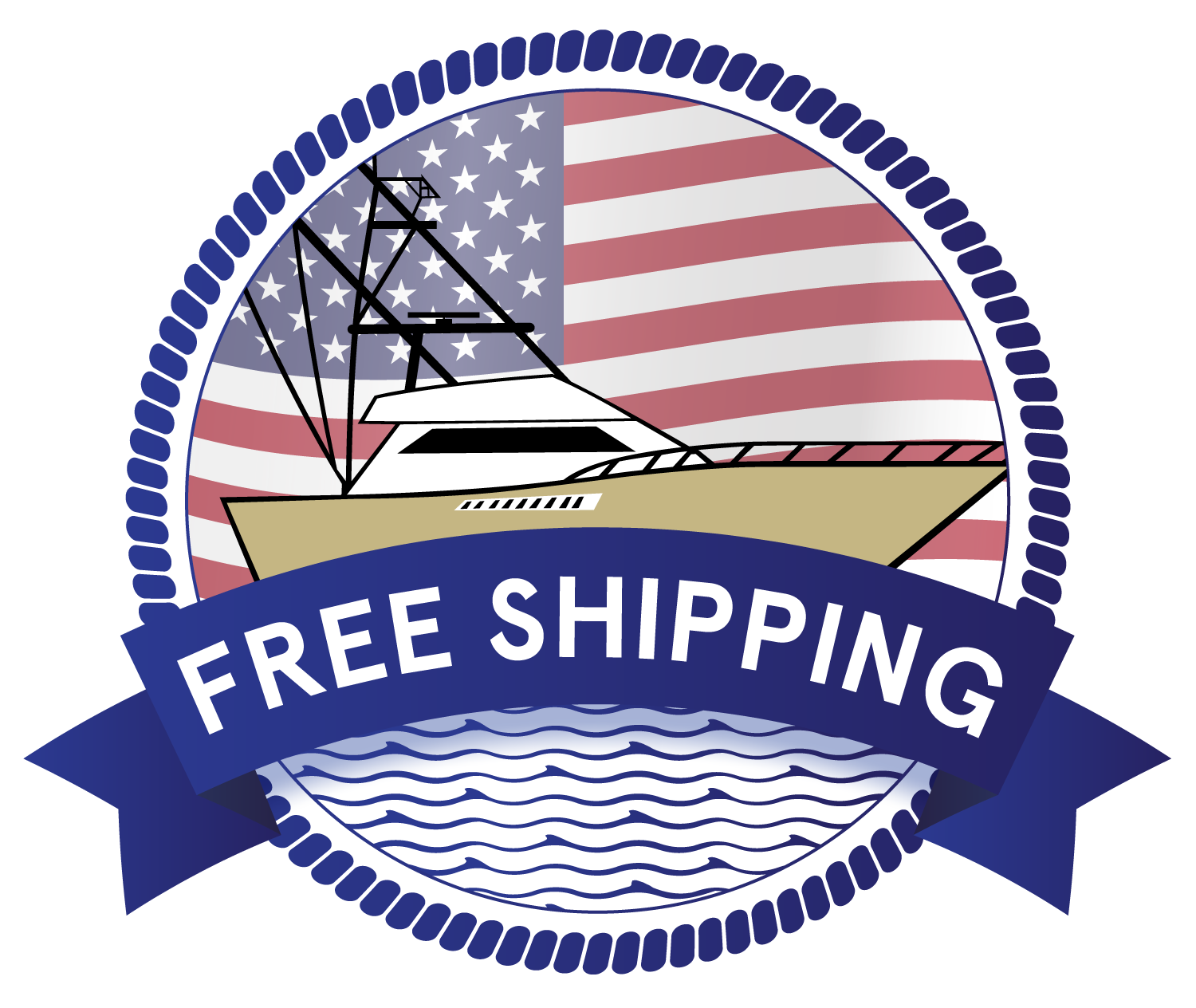
- No Sales Tax on Purchases Outside of California
- Shipping times on pages only apply to paid shipping
- Expert Customer Service
- Distributed by Imtra in North America
International Customers: We Ship Worldwide, Shipping Cost May Quote Too High on Our Web Site, contact us for a quote.
Related products.

Lofrans LW7921 Project 1000 Capstan 12V - Vertical Electric Windlass
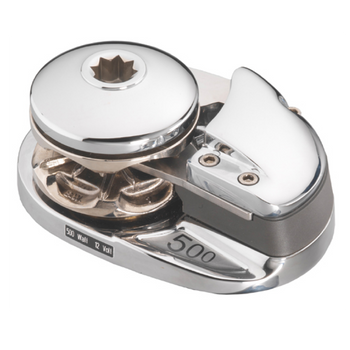
PROJECT 500 Low Profile 700W 12V - Vertical Electric Windlass LW7911LP

PROJECT 1500 Low Profile 1700W 12V - Vertical Electric Windlass LW7962LP
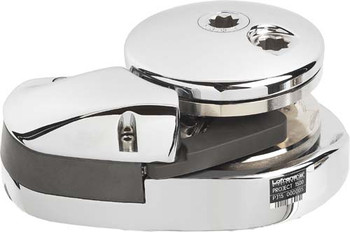
PROJECT 1500 Low Profile 12V - Vertical Electric Windlass LW7942LP

Lofrans Project 1500 Capstan 12V - Vertical Electric 1500W Windlass LW7942
- MarketPlace
- Digital Archives
- Order A Copy

Servicing your electric anchor windlass
An electric anchor windlass is a standard piece of gear on a power voyaging yacht. One of its great advantages — other than pulling up the anchor for you — is that it requires practically no periodic maintenance other than an occasional fresh water rinse, and in the longer term, an oil change. But even though it is likely one of the more reliable machines on your power voyaging boat, you should still know how to perform basic winch maintenance. After all, when you need to reset your anchor at oh-dark thirty when the wind is howling, you certainly want it to work properly.
But before you tear into your windlass, do yourself a big favor and order a replacement seal kit for your particular windlass. The Internet will provide sources of parts, and also drawings or diagrams of your windlass. While this article is specific to the Lofrans Tigres windlass we own, it is of general use, as most electric windlasses follow the same general construction.
Lofrans recommends that the lubricating oil be changed every four years, and that’s where the fun begins. There’s no drain plug, only a filler hole and a sight glass for the oil level. To remove the old oil, the windlass must be unbolted from its mounting on the foredeck and physically inverted to pour out the oil through the fill hole. While going to that amount of effort, removing the electric motor to inspect the brushes and drive gear is relatively easy, and also a wise thing to do. Be sure to pour out the oil before unbolting the motor, lest the oil come out with the motor! Collect the old oil and inspect it carefully for metal particles or water. If the oil is cloudy, then you have a water problem.
Label the wires Three bolts hold the motor to the windlass housing, and the three electric cables are easily removed from the motor. You will wisely label the wires before removing them. Inspect the brushes and commutator for excess wear, and clean out the carbon dust as best you can. Gently pull each brush lead to ensure that the brush moves easily in its holder. The spring tension should be uniform on all four brushes. Treat any corrosion noted. Check the motor shaft for excessive play indicating worn out bearings. Inspect the gear on the end of the shaft for excessive wear or chipped teeth. Remove the chain gypsy and set it aside for a good cleaning. It’s probably held on with a circlip (snap ring) or two. If these are rusty or damaged, replace them with stainless steel circlips. Look for replacements at auto part stores or stores that specialize in bearings and seals — they probably can supply your seals and O-rings, also. Buy an extra set for spares.
The first time that I serviced our windlass, I found that the shaft key that fits in the chain gypsy drive cones had almost torn out of the keyway in the relatively soft stainless steel shaft. (I admit to overloading the anchor windlass when we fouled our anchor in coral in the Tuamotus in the South Pacific.) The local machine shop agreed to machine the shaft for the next largest key, and also to cut a second keyway in the shaft and gypsy drive cones on the opposite side of the shaft from the original keyway. This modification has proved to be trouble-free for 10 years, and is certainly worth considering for your windlass. Ball bearing supports The shaft is supported by two ball bearings that should last forever, unless salt water has reached them. Gently clean them with a solvent such as WD-40 or clean diesel fuel, and rotate them slowly while feeling and listening for rough spots. NEVER spin a ball bearing with compressed air! You may as well drop it in the sand — the long term effects are about the same.
• Replace the oil seals, even if they do not show signs of leaking. They are not expensive and should be replaced if at all possible.
• Inspect the shaft gear for signs of excessive wear, chipped teeth, etc.
• Remove the rope capstan and inspect it for wear as you did the chain gypsy.
• Inspect the windlass housing for signs of cracks, and for corrosion especially around the bolts on the chain stripper and on the pawl bolt. These two areas are problematic as the housing is aluminum, the bolts are stainless steel, and they are regularly saturated with saltwater. If the corrosion is not too severe, it can be repaired with J-B Weld or Marine-Tex or an equivalent two-part epoxy material. The original chain stripper on our windlass tends to bend, requiring occasional adjustment. I ordered a new one, with the idea to install it next to the original one to obtain double thickness and hopefully double strength. I was pleasantly surprised to find that the new chain stripper was almost twice as thick as the original. Our windlass had a white powder coating when purchased. Starting anew, a better choice would have been the clear anodized finish as it is much more durable and thus less prone to chipping and corrosion. We had our windlass housing treated for corrosion and repainted during this last service.
Lubricate the new O-rings Reassemble the windlass in the reverse order of disassembly, carefully replacing the various O-rings and oil seals. Lubricate the new O-rings and oil seals with oil prior to assembly. Place the ball bearings in a plastic bag in your freezer for a half hour to shrink them a bit and thus make them easier to install.
Clean the threads of all of the bolts before reassembling the windlass. Replace any rusted or damaged fasteners. Use an anti-corrosive treatment such as Duralac on all mating surfaces of dissimilar metals. The mounting bolts for the windlass should be isolated from the windlass with insulating bushings.
When we replaced our previous windlass, we found the right rear mounting bolt on the new windlass was directly over the chain pipe — definitely a big problem. An elegant solution to this serious installation problem was to fabricate a mounting plate of 10mm thick aluminum. The mounting bolt was inserted from below the plate and a dab of epoxy kept it from turning, as it was then beyond the reach of a wrench. The other three mounting bolts were installed from above and terminated in backing plates under the foredeck. This idea, or some variation of it, may serve you well on your next windlass installation.
After reconnecting the power cables, coat the terminals with silicone grease to prevent corrosion. Seal the power cable opening in the windlass housing with RTV silicone sealant. Pay particular attention to the bolts that hold the motor housing in place, as they are prone to leak. Self-amalgamating electrical tape wrapped around the bolts at the point of contact with the interior of the housing, followed by a dab of RTV silicone sealant over the nuts and washers on the outside should prove to be watertight.
Check the windlass control box and remote control for signs of corrosion before returning the windlass to service. Oh, and don’t forget to fill the windlass with lubricating oil. Most windlasses use heavy gear oil, SAE 80 or SAE 90. Mark your calendar to do all of this again in four years.
Harry Hungate and his wife Jane Lothrop are long-time liveaboards having voyaged since 1997. They are currently cruising in the Mediterranean.
By Ocean Navigator

- Anchor & Dock

Anchor Windlasses

Horizontal Windlasses

Vertical Windlasses

Anchor Rodes
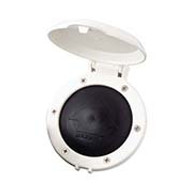
Switches & Solenoids

Maxwell Covered Foot Switch
Maxwell Marine Covered Foot Switch Maxwell heavy-duty, weather resistant units have a UV stabilized water proof diaphragm and are supplied complete with mounting instructions and screws. Rated at 200 amps and suitable for 12V or 24V applications...
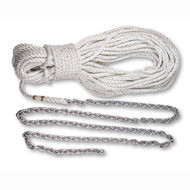
Lewmar Premium 3-Strand Anchor Rodes
Lewmar Premium 3-Strand Anchor Rodes - Marine Grade with Rope & Galvanized Chain Lewmar anchor rodes are a great economical choice for boaters looking for a windlass rode. These rodes are designed to work with the rope-chain gypsies fitted to all...
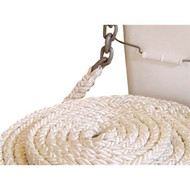
Lewmar 8 Plait Anchor Rode
Lewmar Anchor Line 8 Plait Lewmar Anchor Rodes feature 8 plait nylon line joined with a tapered splice to ACCO Hi-Test hot-dipped galvanized chain. Each anchor rode comes with a shackle to attach the chain to the anchor. Anchor rodes complement rope...

Sea Dog 316 Stainless Anchor Swivel
Sea-Dog Stainless Steel Anchor Swivels Sea Dog investment cast AISI 316 stainless steel swivel anchor connectors are designed to easily slide of anchor rollers, preventing snagging which minimizes wear on the bow roller and windlass. These precision,...

White Deck Foot Switch
Lewmar White Deck Foot Switch Lewmar deck foot switches are single direction switches and come ready to install. With a hinged cover to prevent accidental operation, they are suitable for DC electric windlasses running on 12 or 24 volts and must be used...

Lewmar V700 Vertical Windlass w/ Solenoid & Rocker Switch
Lewmar V700 Vertical Windlass w/ Solenoid & Switch With its 100% 316 stainless steel housing and a sleek flush-mount design that conceals the motor, the economical Lewmar V700 Vertical Windlass is one of the most attractive and durable components...
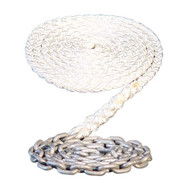
Maxwell 8-Plait Nylon Anchor Rode
Maxwell Marine 8-Plait Nylon Anchor Rode 8-Plait Nylon Anchor Rode for Anchor Windlasses. Maxwell Marine 8-Plait Nylon Anchor Rode

Maxwell SP5104 Reversing Solenoid
Maxwell Marine SP5104 Reversing Solenoid 12V DUAL DIRECTION SOLENOID Used in conjunction with remote up/down panel, Auto Anchor™ 500C/RC, roving hand held remote control and/or foot switches to switch the motor in the required direction...

Sea Dog Windlass Foot Switch
FOOT SWITCH- Stamped 304 Stainless/Rubber Cover. Switch is normally off with momentary on when deppressed by foot. 30 Amps

Maxwell Emergency Crank Handle F/RC & Freedom Series
Maxwell Marine Emergency Crank Handle F/RC & Freedom Series For use with RC8, RC10 Series anchor winches. Two sizes are available to suit the constraints of most foredeck configurations. Constructed of light weight, durable injection-moulded...
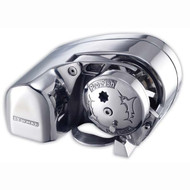
Lewmar Pro-Fish 1000 Windlass
Lewmar Pro-Fish 1000 Windlass The NEW Freefall Horizontal Windlass is the ultimate windlass for fishermen. The horizontal Pro-Fish has an automatic freefall that allows you to pull right up over a wreck or ledge, and drop anchor with speed and precision...
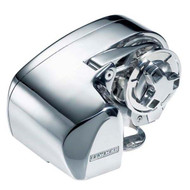
Lewmar Pro-Series 700 Horizontal Windlass Kit w/ Switch & Solenoid
Lewmar Pro-Series 700 Horizontal Windlass Kit w/ Switch & Solenoid Praised by professionals worldwide, the horizontal Pro-Series is a shining example of Lewmars commitment to provide quality products for boats from 6m-11.5m (20-38ft). Its DIY-ready,...

TRAC Anchor Rode
TRAC Anchor Rode TRAC Anchor Rode is a strong yet cost-effective rope and chain combination designed to work with all TRAC brand and other drum winches or windlasses. This rope and chain combination is made of premium windlass-grade double braided nylon...
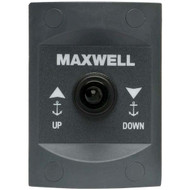
Maxwell Up/Down Anchor Switch
Maxwell Marine Up/Down Anchor Switch Easy to use panel-mounted Up/Down switch for remote windlass operation from the helm, flying bridge or cockpit. Available for use with dual-directional solenoids. Manufactured from marine-grade materials. Splash...

Lewmar Pro-Sport 550 Windlass
Lewmar Pro-Sport 550 Windlass Lewmar's Pro-Sport rope/chain windlass is designed as an economical package for rope and chain applications, without compromise to quality or performance. Pro-Sport is designed around a highly efficient spur gearbox, using...

Lewmar Guarded Rocker Switch
Lewmar Guarded Rocker Switch Lewmar's Guarded Rocker Switch controls the up and down function of all Lewmar anchor windlass models. The switch can be mounted at the helm as the main switch for operation, or mounted at a second station as a secondary...
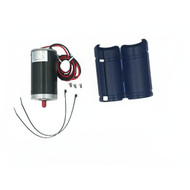
Lewmar V700 Windlass Replacement Motor Kit
Lewmar V700 Windlass Replacement Motor Kit This is a genuine Lewmar OEM replacement motor kit for a V700 Windlass.

Maxwell 135 AMP Breaker/Isolator Panel
Maxwell Marine 135 AMP Breaker/Isolator Panel Maxwell circuit breaker/isolator panels are available to suit a wide range of windlasses and capstans. For protection of the main conductor circuit for DC winches Mount as close as possible to the...

Maxwell 80 AMP Breaker/Isolator Panel
Maxwell Marine 80 AMP Breaker/Isolator Panel Maxwell circuit breaker/isolator panels are available to suit a wide range of windlasses and capstans. For protection of the main conductor circuit for DC winches Mount as close as possible to the battery...
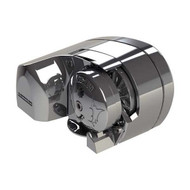
Lewmar Pro-Fish 700 Horizontal Free Fall Windlass
Lewmar Pro-Fish 700 Free Fall Windlass with Switch & Solenoid The Lewmar Pro-Fish is the ultimate windlass for fishermen. This windlass has an automatic freefall that allows you to pull right up over a wreck or ledge and drop anchor with speed and...
Windlasses, also commonly called winches, are a key element of every boat’s anchoring system. These devices are engineered to restrain and manage anchor chains so that they can be lowered or hoisted from the water. Notches located in the anchor windlasses’ gear wheel engage the links of the chain or anchor roping. These are the integral elements in every anchoring system that receive a lot of wear and tear through strain and friction and occasionally require replacement. Whenever any of your boat’s windlasses malfunction, give Wholesale Marine a call. Our team will have you safely back on the water in no time! Everyone at Wholesale Marine is well-versed in windlass anchor systems and can offer sound advice on exactly what part of your anchoring system your boat requires.
Leading Marine Brands of Windlass Anchors
You can depend on Wholesale Marine to maintain an inventory of only the best brands of windlasses including Anchorlift , Lewmar Marine , Maxwell , Powerwinch , Sea Dog Marine , and Trac Outdoor . Whether you are seeking a dependable windlass like the Lewmar V700 Vertical Windlass with Solenoid and Rocker Switch or a simple Anchor Rode from TRAC , you’ll find the solution to your anchoring system at Wholesale Marine.
There are numerous considerations you should be aware of when selecting a windlass, so be sure to consult with the team at Wholesale Marine for the best advice. Making the right windlass anchor choice will ensure many successful seasons of secure anchoring. You can also always rely on Wholesale Marine to stock the right parts at affordable prices. Be sure to contact us if you have questions about windlass anchors or if you need to place an order. We’re available at (877) 388-262, Monday through Friday from 9:00 AM to 6:00 PM EST. Be sure to ask about our Captains Club Rewards Program for additional savings when shopping at Wholesale Marine.
Subscribe to our Newsletter
Get the latest updates on new products and upcoming sales
Oops, something went wrong. Please try again.
You are now logged in!
- Pontoon Boats
- Personal Watercraft
- nauticalknowhow
- Nautical Knots
- Tools and Calculators
The 7 Best Electric Boat Anchor Winches for 2024
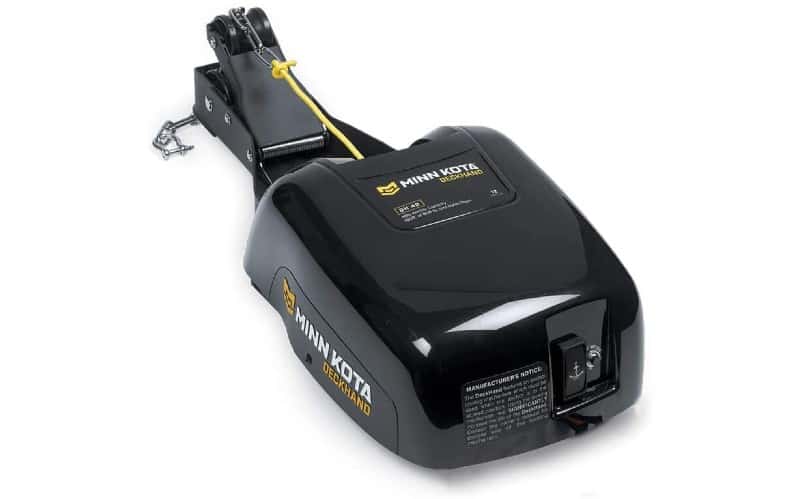
Minn Kota Anchor Winch
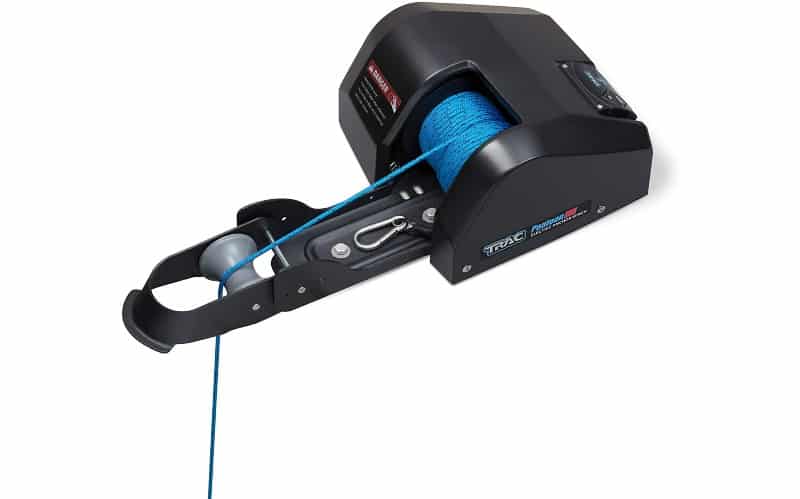
Trac Outdoors Pontoon 35 Electric Anchor Winch
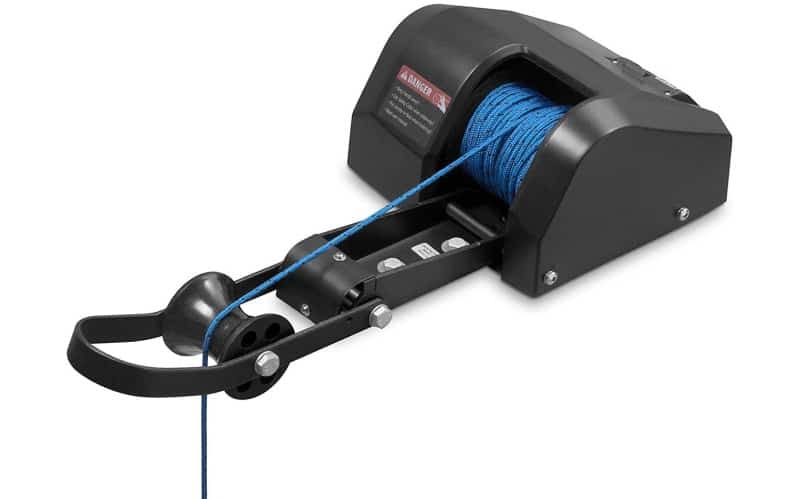
Pactrade Marine 35 Electric Motor Winch
Not every boater thinks of getting an electric anchor winch at first. If you are serious about boating, it really is a must have item. Whether you like to fish on your bass boat or just relax at sea, a winch can be a lifesaver. Manual hauling of your anchor is something any boater gets sick of really fast.
Choosing the best electric anchor winch involves a few factors. You need to make sure it will work for your size boat and anchor. It’s also important to choose a saltwater winch if you’re at sea rather than inland. The last thing you want is a freshwater winch in the ocean. Let’s take a look at some of the best electric anchor winches on the market. These should be more than adequate for any kind of boat you may have.
The Minn Kota Pontoon Deckhand is hands down one of the best electric anchor winches. This winch is rated for a 40lb anchor. That means you want to scale back to at least 35lbs. Lower is fine as well. Remember, the reason for this is to ensure your winch lasts as long as it can. Pushing a winch to capacity, like with a 40lb anchor, is going to cause it to burn out too soon. Always go at least 5 or 10lbs less than recommended.
The winch comes pre-spooled with 100 feet of rope. That’s pretty standard in the industry. In this case it’s an 800lb test nylon rope. That should be able to stand up to whatever you need. Remember the rule for depth is 3:1. If you fish deeper waters, you’ll need more rope.
The universal davit can stay with the winch or be mounted further away. It allows you to store the anchor horizontally. Other features include a quick release, a remote control and a quick connect plug. Take note that this is not a cordless remote, instead it’s a corder remote. A corded remote is bad for a TV but not terrible for a winch. It’s much harder to lose a corded remote, afterall. The cord is 25 feet long, in case you were wondering. That means you still have freedom of movement on deck.
There is an anti-drag system which is extremely helpful as well. It senses when the anchor hits bottom. This means you’ll endure less drifting.
Installation is fairly easy with this winch. Give yourself an hour and you should be hand. It’s extremely versatile in the ways you can mount it, which is great. It can find a place to fit in nearly all boat shapes and sizes.
Minn Kota offers a two year warranty. That puts it ahead of a number of other brands. It’s worth noting that the battery cable is actually pretty short. This can affect where you plan to install it unless you get additional wiring.
- Buy on Amazon →
- Buy on Bass Pro →
- Buy on Walmart →
The Trac Outdoors 35 is ideal for pontoon boats . It can work with any boat up to a 35lb anchor, though. You’ll see throughout our reviews we always tweak those numbers. If it says 35lbs, we recommend 30 lbs or less. The reason is that an electric winch should never have to run at full capacity. The strain on the motor will cause it to wear out far too soon. Always go at least 5lbs lower with your anchor weight.
This winch comes spool with 100 feet of 800lb test rope. It’s 3/16-inch braided anchor rope so expect it to have some durability. The gears are all steel and can be expected to last. The motor is 12-volt and won’t cause havoc with your boat’s battery. We always recommend the use of extra solar panels if you are worried about battery drain. Solar panels are easy to install and can provide a real boost to your boat’s energy levels.
The anchor roller can be integrated with the winch or used separately. It all depends on the size of your boat and how you install it. That versatility makes it ideal for many boat shapes and sizes.
Installation is easy with the included instructions. Expect to spend about 30 minutes or so getting it done. There are handy videos on YouTube which can walk you through the process if need be. All the hardware you need is included.
The wiring is all marine grade. That means it will resist corrosion. There is a sealed membrane to hold out water and keep the inner workings alive and kicking. The winch can drop anchor at 70 feet per minute. It reels it back in again at 65 feet per minute. The entire unit is compact which makes it ideal for smaller boats.
Trac offers a one-year warranty on the winch to give you peace of mind. If you see a trac anchor winch review that mentions two years, check the date on it. That may have been true back in the day, but not right now.
With the price and the features available, this is our pick for the best overall winch. It has everything you need and is reliable. It doesn’t have a wireless remote control, but that’s really a premium feature, we think. If you need a versatile and high quality electric winch, look here.
Pactrade ranks in with a solid entry. The Marine 35 is their freshwater electric winch. You definitely don’t want to put this in saltwater. It will get corroded very fast. It will also void the warranty, so keep that in mind.
The 12-V motor is low amp and draws little power. As with any electrical components, if you’re worried, try adding solar panels to offset the draw. The wiring is marine type 14-gauge. That means it’s going to be pretty reliable. The winch works best with mushroom and river anchors.
As the name implies, this is rated for a 35lb anchor. We recommend 30lb or even 25 for maximum benefit. The braided rope is 100 feet and has an 700lb break strength. Some sites that sell these say it’s 800lbs. Pactrade’s own info says 700lb, so trust them. Many other ropes will get to 800lbs. If you’re used to 800lb strength, be extra cautious here. It may not stand up to some of the abuse you’re used to.
The switch is part of the winch cover and offers power up and down. The anti-reverse internal clutch will stop that spooling problem.
For the price, you’re not likely to find a winch this reliable. It doesn’t include a remote control, however. As we said, the rope may be a little underpowered as well. But it’s also very easy to upgrade if need be.The foundation is solid and very affordable.
Pactrade offers a one-year warranty on the winch. The kit comes with everything needed for installation as well. You may want to check out some videos on YouTube if you’re not familiar with the wiring you’ll need to do.
Pactrade Marine Pontoon Salt Water Electric Winch
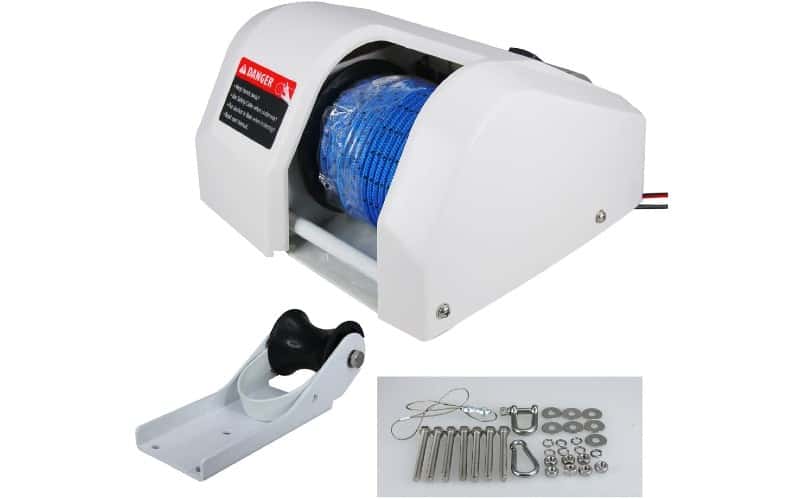
Pactrade’s saltwater electric winch for pontoon boats is reliable and affordable. The 12-V, 150 watt motor is powerful but energy efficient. It’s not going to drain your battery dry by any means. And if you’re worried, using an extra solar panel to offset the draw is always an option. With the power available, the winch pulls a respectable 3800 revolutions per minute.
The cover is UV protected to handle long days in the sun better than most. The 10-gauge wire is tin plated. That helps resist corrosion out on the sea. The case is sealed to keep the sea water out as well.All hardware is stainless steel.
In terms of features, one nice touch Pactrade included is the safety cable. That can secure your anchor when not in use. The anti-reverse internal clutch won’t allow your rope to get tangled as you reel it in.
This is rated to handle a 20lb anchor. That’s definitely on the low end of the spectrum. The bow roller is also a little short for this winch. That means it’s definitely better suited to a smaller boat. If you have a larger boat, try one of our other suggestions. However, for a smaller saltwater vessel, this is ideal.
Power 4S 12V Anchor Winch
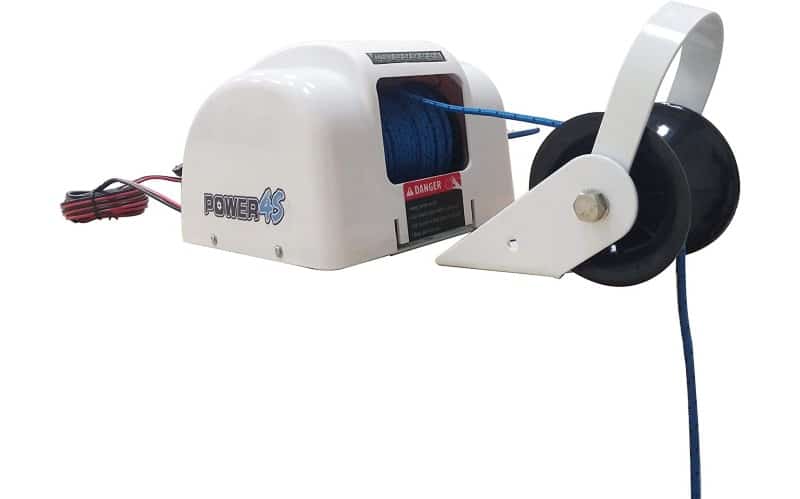
If you’re looking for a saltwater winch, the Power 4s may work well. Perfect for a pontoon boat with a 30lb anchor. It comes pre-spooled with 100 feet of rope and a remote control for easy operation. As with all of our recommendations, you may want to tweak the weight capacity here. This is rated for a 30lb anchor. We recommend dropping to 25lb or even 20 if possible. It’s never a good idea to push a winch to its limits. This is not a requirement, just a suggestion. It can help eliminate the potential for accidents or breaks.
There is a sealed membrane switch and 10-gauge tin plated battery wire. This is all to reduce corrosion and shock risk. As a saltwater anchor winch, it needs that extra protection. Power up and down is available and also a freefall mode for the anchor. The mounting equipment includes clips to hold the remote control in place as well. There is no fuse to install and it comes with a circuit breaker.
The Power 4S has a seperate anchor davit. The roller can be positioned close to the winch or moved away. It’s easy to adjust based on which position works best. The kit includes 100´×0.20″(30.5m×5mm) braided anchor rope. When installed, it offers a 70 ft(21.3m) per minute no-load rope retrieval speed. It’s strong and sturdy and should handle your needs well.
There is a one-year warranty that is included with the winch as well. It may not be the best in the industry in terms of time. Still, compared to a winch that offers no warranty at all, it’s a superior choice.
Saltwater winches can get pricey. In fact, our next winch is nearly double the price of this one. But if you need one that doesn’t require a huge weight capacity, this is a solid option.
$382.00 Amazon →
Prosport 550 Windlass
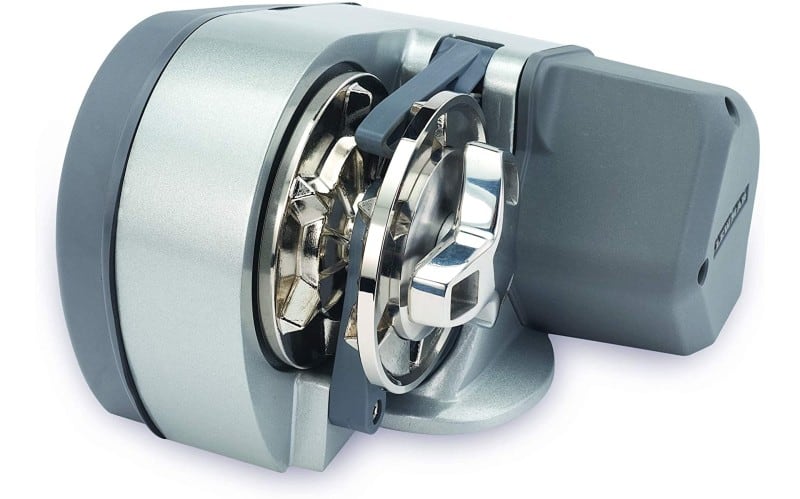
The Pro Sport 550 Gypsy Windlass is a serious piece of machinery. This is rated for 550 lbs. That’s the boat working with the anchor, of course. You wouldn’t have a 550lb anchor. That said, this is rated to handle boats up to 28 feet. Pay heed to this. Amazon lists it at 40 feet. Lewmar’s own product details recommend 28 feet. It can handle a heavy anchor though, and it is fast. Not dangerously so, but faster than other models we have listed.
This is one of the models that does not come with a rope already spooled. We included it because it is a powerful winch. If you have a larger boat, this may be the best electric anchor winch for you.
Like the other winches it has a low power draw. It doesn’t use a remote control but the kit for installation includes the mounting hardware you need. You’ll find the mounting gasket, circuit breaker, toggle, and studs. Installation is totally DIY. It may seem daunting but you can probably get it done in 30 to 40 minutes. Follow the included installation instructions and you should be fine.
The windlass features a manual freefall and dual direction power. It has an above-deck installation. It uses small, permanent magnet motors for reliable power. The center case is made from aluminum while the side covers are composite. That means it’s saltwater ready. It can stand up to the corrosion others can’t. Keep in mind you still want to keep it clean and dry whenever possible.
Lewmar offers a three year warranty on this windlass. That’s a definite bonus to offer peace of mind if you’re concerned. If you want maximum anchor capacity this may be the best electric winch for you.
$795.46 Amazon →
Picking the Best Electric Boat Anchor Winches
There are two main types of electric boat anchor winches. It should come as no surprise you can get an electric boat anchor winch for saltwater or freshwater. You never want to use a freshwater boat anchor winch in saltwater. If it has not been designed for saltwater, it’s a recipe for disaster.
A saltwater electric winch will be designed to resist corrosion. This is very important. A freshwater electric winch is designed for use in lakes and rivers. These are often cheaper than saltwater winches.
In addition to the water it’s used in, your winch can have different orientations. That means the anchor winch can be set up to operate horizontally or vertically.
Horizontal Electric Boat Winch: These are typically used on smaller boats. If you don’t have the space for a vertical winch, this may work for you. It can handle more than one anchor as well. The downside of a horizontal winch is that it is more prone to slipping. They can cost more to fix if something goes wrong, also.
Vertical Electric Boat Winch: These are more common on most boats. Set up of this kind of winch is often fairly straightforward. They jump less than a horizontally mounted winch will as well. Since maintenance of these is easier, most boaters prefer them.
You need a high quality winch if you want it to last. Some cheaper brands will use plastic components. You can find reviews all over Amazon complaining of these types of winches. They might only last for three or four uses. After that an important gear or pin breaks because it was poorly manufactured. The entire winch is useless at that point.
Ideally you want a completely sealed case. This will protect the circuits and electronic components from moisture and corrosion. The gears should be steel to maintain strength and reliability. Wiring should be tin which can stand up to corrosion long term as well.
The motor for your electric anchor winch is no good if it draws too much power. It’s also not going to be helpful if it’s not powerful enough to do the job.
12 volt motors are standard for most electric winches. These offer suitable power and don’t drain power needlessly. Make sure your anchor matches up with in terms of size with the capacity of the motor. If you try to haul in a larger anchor than the motor can handle, it will burn out quickly.
A marine solar panel is a good idea if you’re concerned about power. Installing one of these can further minimize any power used by your motor. Typically these don’t draw a ton of energy. If you factor in everything running on your boat’s battery, it never hurts to have a buffer. We recommend solar panels for any boat.
The motor needs to be sealed well, especially if you boat in saltwater. The motor will be one of the first things to fail in saltwater if it’s not well made. The corrosion sets in faster than you might think. It can be a real hassle to deal with.
Buying a winch with pre-spooled rope is easy and convenient. If you need to replace rope make sure you look up the kind you need and how to do it. It’s possible to buy a winch that does not come with rope and spool it yourself. We don’t recommend this because why bother? The companies that manufacture winches have already done the work for you. You can count on it being the right length and strength for the job. No need to make more work for yourself if you don’t have to, in our opinion.
When you do need to buy your own rope the standard rule of thumb is 3:1. You need a rope that is three times as long as the water you are in. This ensures you can safely anchor your boat. In general, most electric boat winches come with 100 feet of rope.
Look for an anti-reverse clutch system. This is important to prevent tangles and jams. If you don’t have a system in place, the rope can spool and get tied up.
You probably want to go with a braided anchor rope. Braided rope made from nylon is strong and resists abrasion. Polyester rope is also a popular choice. Whatever kind of rope you get, make sure it’s rated for use in an anchor winch. It needs to be able to handle being wet regularly without getting damaged.
You need to consider what your rope has to endure even when sitting still. If the current starts pushing your boat, the rope is the only thing keeping you steady. It will bear the weight of the entire vessel. Now imagine it’s underwater scraping against a rock or some coral at the same time. Strong rope has to not just pull up a 30 lb anchor. It also has to keep several hundred pounds of boat from floating away by not breaking.
Most rope is rated for about 800lbs. Some clock in at 700 lbs. Be wary of what you buy and what you need it to do.
Obviously one of the big drawbacks to an electric boat winch is cost. Lugging a rope in by hand costs you nothing in terms of dollars. Some electric anchor winches can cost over $500 depending on their size.
Many good quality anchor winches can be picked up for under $200. The cost can still seem steep, over time the value will become apparent. These are great tools to have. They are definitely worth the investment for serious boaters.
Some anchor winches can be picked up for $100 or even less. You should always exercise caution if you see anything this cheap. The expression “you get what you pay for” does apply here. If it’s too cheap, be very cautious. Do your homework and check reviews from multiple sources. If you can’t find reviews at all, that’s a red flag. More often than not you’ll see most reviews are not very high for such an anchor.
If you are looking to save money but still get quality, you have options. Used anchor winches are usually available on sites like craigslist. You may also have luck at your local marina. Make sure you test it out before buying, however.
We recommend all the models we have posted above as being reliably and fairly cost effective. Obviously the ProSport Windlass is a standout in terms of cost. That said, it is recommended for heavier vessels.
Along with cost comes warranties. It’s always good to look into the warranty that is offered with any winch. Because this is a big purchase and affects the overall function of your boat, it’s important. Most companies offer a standard one or two year warranty on their products. Make sure you understand the warranty fully before you commit. Certain things can affect the warranty or even void it outright.
Installation
Modern electric anchor winches are usually not too hard to install. That said, if you buy one from a company overseas it may not come with instructions. That can make it difficult to figure out. When researching the winch you want to buy, check out YouTube ahead of time. See if there are any videos that walk you through the installation process. You may be surprised to see that there are many models featured with step by step walk throughs. This can offer you peace of mind when it comes to getting it installed correctly. Most people have never installed an electric anchor winch before. Don’t feel bad if you’re unsure of the process and need a hand.
Operating Your Electric Boat Anchor Winch
When it comes to operations, there are two standard methods. Remember, a manual winch used to be the only way. That involved a lot of hand cranking and a lot of effort. Electric anchor winches save a lot of time and effort.
Remote Control Anchor Winches: As the name suggests, you can use a remote control to operate these. Just like the TV, you can get it going from anywhere on the boat. This is convenient if you’re busy at the other end of the boat and don’t need to walk all the way to the winch.
Switch Controlled Anchor Winches: These are ones you have to control directly. The switch is hard-wired to the winch. Usually it’s located right next to the winch. Sometimes you can have these hardwired to the control console as well.
Regardless of how a winch is operated, speed is typically static. That means you can’t usually make your anchor winch speed up or slow down. This is a safety precaution more than anything. You don’t want a winch that can pull up an anchor too fast. Usually a winch will drop anchor much faster than it pulls one in, however.
Things to Watch Out for with a Boat Anchor Winch
Make sure you pay attention to the weight capacity. In general, an electric anchor winch will have a capacity between 20lbs and 40lbs. For most boats this is more than sufficient. It’s in your best interests to be cautious here. Just because the winch capacity is 35lbs doesn’t mean a 35lb anchor is ideal. There can be circumstances in which extra stress is put on the winch. In those cases, a 35lb anchor could become problematic. We recommend overshooting your anchor slightly. Use a 40lb winch for a 35lb anchor. A 35lb winch for a 30lb anchor and so on. This is just a safety precaution. You don’t have to do it by any means. It’s also possible your winch will work just fine at capacity. But for added caution, consider tweaking your numbers slightly.
You may think you need a larger winch. This is only true if you have a larger boat. These electrical anchor winches are specifically made for small to medium boats. The kind that could reasonably be used without an anchor winch. Larger boats should already have anchor winches as part of the overall boat design. A 65 foot yacht would not need any of the winches we’ve listed here. It should already be well equipped with a high quality anchor winch of its own.
For these smaller boats, larger capacity winches are rarely necessary. Your anchor is likely not that large so it doesn’t make sense to worry about a larger winch.
A homemade boat anchor winch is something you may see on the water now and then. These are typically manual and not electric. Sometimes they’re rigged from automobile winches. There’s nothing to say this won’t work but do be cautious. If you’re not a handy type person, we don’t recommend risking it. The risk of a jam or break can definitely increase with this.
Watch out for a noisy winch. Ideally this should not make a ton of noise as it rolls in and out. Some are definitely noisier than others, though. If your winch starts making new noises it’s a good sign something is wrong. The winch itself needs to be well lubricated in order to avoid this. If you hear grinding or squealing you definitely have a problem.
A good davit can go a long way to preventing excess noise. The davit is the part that reels the rope in and keeps it straight and smooth as it winds. Without it, the rope can spool. That can cause the entire winch to start making noises as it will be off balanced.
Manual vs Electric Winch
Using an electric winch instead of a manual winch obviously saves time and effort. You’re free to do other things while the winch does the work for you. In addition, your arms and back will likely thank you. Yanking up a rope by hand can be hard for several reasons. The weight can make it a struggle. The friction may also cause serious damage to your hands. You may also end up with a pretty dirty rope. That can cause a mess on you when you pull it in. For those reasons, an electric anchor winch is really the best option out there.
Electric winches also make your boat safer. If you’re spooling rope by hand, it’s going to end up on the deck. This presents a tripping hazard until it is stowed safely. The winch handles that work for you. It’s both a time saver and a space saver in that regard.
The Bottom Line
An electric boat anchor winch is a real time saver on any boat. It gets the dirty work done for you so you can focus on other things. It’s a cool gadget too, and there’s nothing wrong with liking more boat gadgets. Make sure you’re focusing on the right kind of winch for your boat. Never use a freshwater winch in saltwater. Make sure you get it installed correctly and you have the right amount of rope to do the job.
My grandfather first took me fishing when I was too young to actually hold up a rod on my own. As an avid camper, hiker, and nature enthusiast I'm always looking for a new adventure.
Categories : Boats
Ed Wise on December 8, 2021
Are there any electric anchor that have a 200 foot rope or more. I am fishing in fresh water 80 to 100 feet on Lake Simcoe, Canada
RobertHan on February 24, 2022
I installed the MinnKota Deckhand 40 on my Tracker ProGuide V175 with remote switch and 30lb anchor. This gives me an extra option over the position (anchor) lock I have with my trolling motor and a ProNav setup. The ProNav is great but if you really want to hold a position in wind and waves you need a real anchor.
Mark G. on September 5, 2022
Hey Robert, I found your review very helpful. I too have a Tracker 175. The boat came with a trolling motor on the front. I’m concerned about putting too much stufff on the front of the boat. Could you send me a picture of how you mounted your anchor winch? It would be greatly appreciated. Thank you for the post.
Leave a Reply Cancel reply
Your email address will not be published. Required fields are marked *
Save my name, email, and website in this browser for the next time I comment.
More in Boats

What Is A Gunwale?

131 of the Best Hawaiian Boat Names

167 Patriotic Boat Names

The 138 Best Boat Names for Dog Lovers

The People’s Poncho Review and Ratings

Oru Lake Kayak Review

About Boatsafe
Established in 1998, BoatSafe is your independent guide into the world of boating, fishing, and watersports. We provide expert insights and detailed guides to help you find products tailored to your needs and budget.
Contact Boatsafe
- Address: 4021 West Walnut Street. Rogers, AR 72756
- Phone: (479)339-4795
- Email: [email protected]
Site Navigation
- How We Test
- Corrections Policy
- Privacy Policy
- Terms & Conditions
- Editorial Policy
- Affiliate Disclosure
Our Reviews

All content is © Copyright 2024. All rights reserved.

Please verify you are a human
Access to this page has been denied because we believe you are using automation tools to browse the website.
This may happen as a result of the following:
- Javascript is disabled or blocked by an extension (ad blockers for example)
- Your browser does not support cookies
Please make sure that Javascript and cookies are enabled on your browser and that you are not blocking them from loading.
Reference ID: cf9d4f0c-1663-11ef-b20d-dd3ac50d3a2b
Powered by PerimeterX , Inc.
- Marine Supplies
- Maintenance & Boating Guides
Docking & Anchoring Equipment
The 5 Best Electric Anchor Winches | 2022 Review
By: Kye Cardinalis Editor
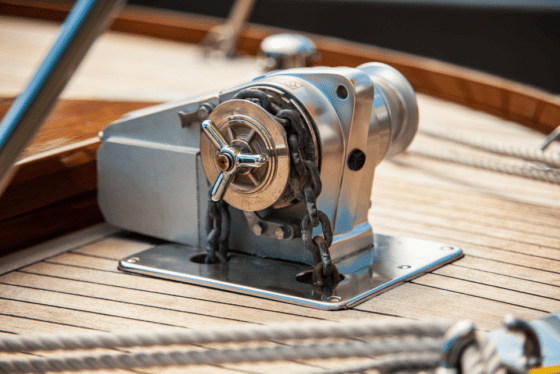
You know you need an anchor to keep your boat in place. But how do you raise and lower the anchor? For that, you are going to need an electric anchor winch. In this electric anchor winch buying guide, we will introduce you to the top products to consider. But first, let’s explain why boat anchor winches are important.
What are Electric Anchor Winches, and Why Do You Need One?
An anchor winch is a device you can use to raise and lower your anchor. How does a boat anchor winch work? Woods Hole Oceanographic Institution explains ( 1 ), “A winch has a large drum or cylinder with thousands of meters of wire wrapped on it. A strong motor turns the drum one way to wind wire on to it, pulling the heavy object closer to the ship, and the other to unwind the wire, letting the object sink farther down in the ocean. A skilled operator controls the winch.”
Without an electric anchor winch, you would have to do all the work of raising and lowering the anchor manually.

Top Anchor Winches in 2022
Below are the top electric boat anchor winches we recommend. If you still have questions about choosing an anchor winch, scroll past the product overviews below for our buying guide.
Best Electric Anchor Winch for Up to 20 Pounds
1. Trac Outdoors AnchorZone 20 Electric Anchor Winch

What we like
- Easy installation.
- Compact and sturdy design.
- 1-year warranty.
What we don’t like
- Some issues were reported with their quality.
- Only useful for freshwater.
If you have an anchor of up to 20 pounds, you can support it with the Trac Outdoors AnchorZone 20 Electric Anchor Winch. Keep in mind that some customers say this product works better if your anchor is actually a bit under 20 pounds. It may struggle close to its weight limit, but it is a solid product overall.
Key Specifications
- 20-pound maximum anchor capacity
- 100 feet of 5/32-inch braided anchor rope
What We Like
- This product offers fast and easy installation. Even if this is your first time installing an electric anchor winch, it will be a breeze.
- The buttons are intuitive and easy to use. They are literally labelled “UP” and “DOWN.”
- The gear motor is made of steel, making it rugged for use on the water.
- The design is compact, requiring only 7.5x 7.5 inches of deck space. So, you can use it even on a small boat.
- Your purchase is backed by a 1-year limited warranty.
What We Don’t Like
- Sometimes users report that the gears strip rapidly on this product, so there may be some issues with their quality.
- This unit is only useful for freshwater. You can actually modify it to use in saltwater with the help of some anti-corrosion spray, but you will void your warranty the moment it touches saltwater.
Best Electric Anchor Winch for Up to 40 Pounds
2. Trac Outdoors Deckboat 40 AutoDeploy-G3 Electric Anchor Winch
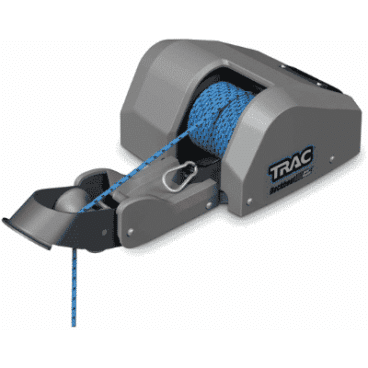
- Excellent weight capacity.
- Marine-grade battery wire.
- Easy to install.
- The wiring may not be long enough.
It is hard to go wrong with a Trac boat anchor winch. The Trac Outdoors Deckboat 40 AutoDeploy-G3 Electric Anchor Winch is similar to the product above, but it has a 40-pound capacity rather than a 20-pound capacity, making it suitable for larger boats and anchors.
- 40-pound maximum anchor capacity
- 100 feet of 3/16-inch braided rope
- This product offers an excellent weight capacity at a reasonable price, representing a solid value.
- As with the product above, you can operate this one using intuitive “UP” and “DOWN” controls.
- The winch features durable manufacturing including marine-grade battery wire and a steel gear motor.
- As with the previous product we shared, this one is easy to install with clear instructions in the manual.
- For some customers, the wiring may not be long enough. It depends on your setup, so you should take some measurements before you order to make sure you will not need to buy more wiring.
Best Saltwater Electric Anchor Winch
3. Generic Electric Anchor Winch
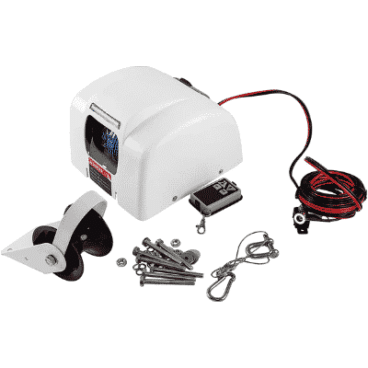
- Safe to use.
- Rust-resistant.
- The automatic resetting circuit breaker.
- Includes a wireless remote control.
- Cannot handle more than 40-45 pounds.
If you are looking for an electric boat anchor winch specifically for the ocean, you should consider this Generic Electric Anchor Winch.
- Maximum weight capacity: 45 pounds
- 100 feet of braided anchor rope
- Available in black or white
- This product is safe to use at sea since it is protected against corrosion and features rust-resistant stainless steel hardware. There are also UV inhibitors to protect it from the sun.
- Not only is this a good product to choose for ocean use, but it is also suitable if you are looking for something that you can operate rapidly. When you press the “DOWN” button, you can drop the anchor in freefall.
- To prevent electrical problems, there is an automatic resetting circuit breaker built into the device.
- What makes this product especially flexible is the option to add a second switch at a location that suits your needs. You also can operate it using the included remote control. The remote is wireless, so you can carry it around and operate it from anywhere.
- We have found sporadic reports of glitching during use where the winch will work on its own without pushing the button, but this seems very rare.
- This product is sold as a “windlass,” but it cannot handle more than 40-45 pounds. This is in line with typical high-capacity anchor winches, but may not be sufficient for larger boats/anchors.
Best Premium Anchor Electric Anchor Winch
4. Five Oceans Anchor Windlass AISI316 Stainless Steel Anchor Winch
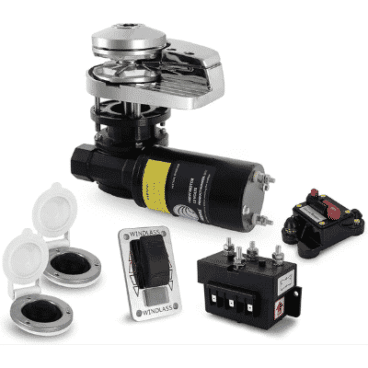
- Stainless steel construction.
- Fast performance.
If you are able to afford some extra expenses and you are looking for a strong, high-capacity product, you might consider the Five Oceans Anchor Windlass AISI316 Stainless Steel Anchor Winch.
- 600-1500 watts (depending on the option you choose)
- Max pulls up to 2,645 pounds (again depending on the option you choose)
- Max working load up to 1,070 pounds (depending)
- Drop speed: 131 feet per minute
- Retrieval speed: 52 feet per minute
- With its AISI316 stainless steel construction and impact-resistant cover for the motor, this is a robust product that can stand up to wear and tear and retain its beautiful shine. Indeed, its aesthetics are such that it can actually enhance the look of your vessel.
- Installing this product on your boat is easy thanks to the inclusion of a heavy-duty lever.
- This product delivers fast performance, even with a heavy anchor. That being said, it might be a little too fast for some people. Be sure you position it in such a way that the anchor will not strike your boat.
- Everything you need is included in the kit, including the windlass itself, a circuit breaker, two different switches, a mounting template, a manual, and a dual-directional solenoid.
- With its high pricing, this product is not suitable for every boater. Also, given the cost, the accessories should be sturdier than they are. The switches in particular seem like they may give out fast.
Best Quiet Electric Anchor Winch
5. Minn Kota 1810140 DH 40 DeckHand Electric Anchor Winch

- Multiple mounting options.
- Noiseless engine.
- Sometimes the anchor may not drop as far down as you need.
Tired of how loud other electric anchor winches can be? If what you need is an electric boat winch that operates smoothly and quietly, one of your best options is the Minn Kota 1810140 DH 40 DeckHand Electric Anchor Winch.
- Maximum capacity is 40 pounds
- 100-feet of nylon rope
- There are multiple mounting options. Installation is not too challenging after you watch videos demonstrating how to do it. If you want to avoid issues with anchor swing, you will be pleased to learn you can stow it horizontally.
- This product includes a special feature that lets you engage in controlled drifting by sensing where the bottom is.
- The motor is larger than it is in a lot of Trac anchor winch products.
- Sometimes the anchor may not drop as far down as you need, especially if it is significantly under the maximum capacity. If you run into that issue, you can just attach more weight.
- Depending on the configuration of your vessel, installation of this anchor winch may be tricky. Also, you have to buy the remote control as an add-on. It is not wireless, either.
What to Look for in an Anchor Winch
Having had a chance to check out some of the top electric boat anchor winches in our anchor winch reviews, you may now want to learn a little bit more about some of the features we talked about for those winches.
Types of Electric Boat Anchor Winches
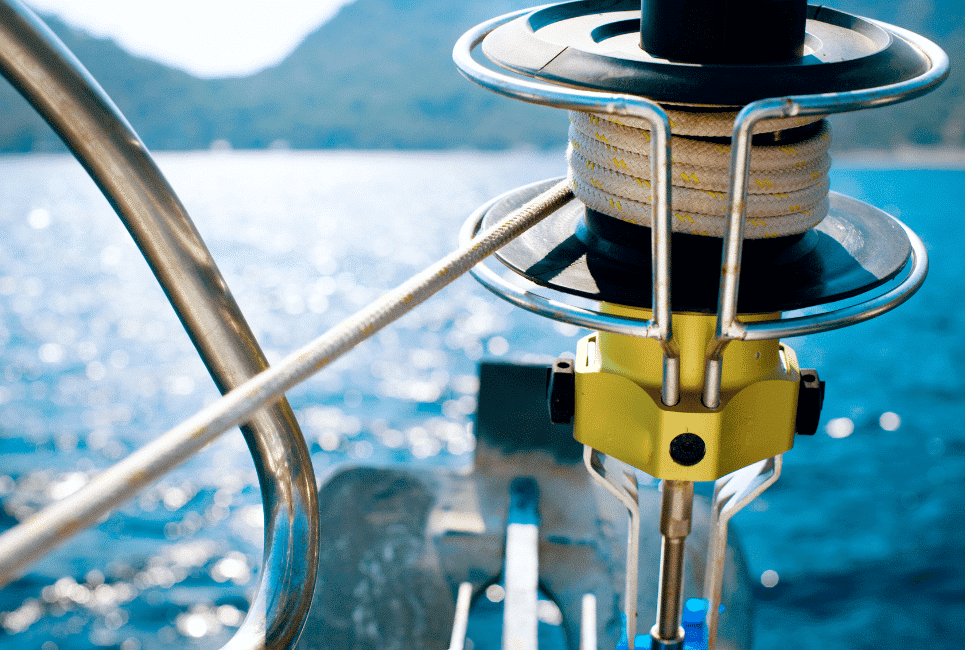
Generally speaking, an electric anchor winch is an electric anchor winch. While these products may have different features, it is difficult to sort them into separate categories.
That said, some people like to separate them into the categories of freshwater versus saltwater. Freshwater-only winches may degrade if exposed to salty conditions like those found at sea. So, if you are looking for a winch specifically to use at sea, you definitely need to invest in a saltwater electric boat anchor winch that is resistant to corrosion.
Another possible way to breakdown winches into categories is to consider their configurations, which may be either vertical or horizontal.
You can conserve space with a horizontal orientation. But a vertical orientation may help with slippage.
Anchor Winch Features
Along with what we just discussed above, here are some additional features to look for as you select an electric boat anchor.
- Safety and reliability . These are among the top considerations for many customers looking for an anchor handling system ( 2 ). Not only should the winch be safe, but it should also be able to operate without the rope getting stuck or other hiccups.
- Capacity . Be sure to purchase a product that can support the weight of your anchor. The lower end of the range you will find is usually about 20 pounds, while the upper end is usually around 40 pounds. But you can sometimes find higher capacities, especially if you are shopping specifically for a windlass. Be aware that sometimes winches have a difficult time if you are operating at or near capacity. So, you should try to purchase a few more pounds of capacity than you think you will need.
- Rope. Find out how much rope is included with the product, if it is pre-spooled, and what type of rope it is, and how thick it is. 100 feet is typical. High-quality material not only means a more durable, long-lasting rope, but better functionality for the entire system.
- Materials and construction. Choose a product that is made out of robust materials like stainless steel, and which includes an impact-resistant cover, a sealed membrane, and corrosion-resistant elements when possible. This is a product you can trust to deliver years of use without being compromised by conditions on the water. Of course, if you want your winch to last as long as possible, you need to do proper maintenance on a continuous basis (see the next section).
- Ease-of-installation. While your boat itself may sometimes impose challenges with installing an anchor winch, in general, it should not be a difficult process. That said, some products are easier and faster to install than others, and come with better instructions. They may also provide you with multiple mounting options.
- Dimensions. Be sure to check the dimensions of the boat anchor winch you are considering, especially if you are looking for small boat anchor winches specifically.
- Ease-of-use. One of the reasons to purchase an electric anchor winch in the first place is to make it as fast and easy as possible to raise and lower the anchor. Intuitive controls that function reliably can help with this, as can multiple controls, including a remote. Remotes can be wired or wireless.
- Motor. The key to fast and smooth operation is a powerful motor. At the same time, you want it to work efficiently. The standard 12 volts is ideal for most situations.
- Volume. Anchor winches can operate pretty loudly sometimes, especially if they are poorly lubricated (thankfully, you can do something about that). But some models are also louder than others. If you find loud anchor winches obnoxious, you should check reviews for feedback on noise levels, and choose a product that has a reputation for being quiet.
- Speed. Boat anchor winches vary in how rapidly they can drop anchor or raise it. If you want a product that can do both quickly, be sure to look up speed data as you conduct your research.
- Cost. Finally, the cost is always a factor when selecting products for your boat. Typically, you will pay somewhere between $150 and $300 for an electric anchor winch. But you can find some premium products at a higher price point if you are looking for extra quality in materials or a higher weight capacity.
- Warranty. When you are investing money in a device like an anchor winch, it is always wise to check the warranty. Around one to two years seems to be a standard for these products. Make sure to check the coverage and not just the length.
Anchor Winch Care & Maintenance
If you want your anchor winch to continue to perform reliably over the years ahead, then you need to take proper care of it with regular maintenance.
A quick wipe-down with soapy water on a routine basis will go a long way toward preventing build-up that would otherwise be difficult to scrub away. Now and again, you might spot some corrosion, even with a rust-resistant model. You should apply rust remover spray when you spot these issues as soon as you are able so that they do not get worse. You also should routinely apply lubricant to the winch so that it can continue to operate smoothly and quietly.
There may be times when you will not be using your boat for a while. In those cases, it is wise to apply some silicone spray to protect the metal. Just make sure that you keep it away from the switch.
You might also be interested in:
- The 6 Best Pontoon Boat Bumpers & Fenders
- The 5 Best Trolling Motor Batteries
In general, it is significantly safer, easier, and faster to operate an electric boat anchor winch than a manual one. The only reason to consider a manual boat anchor winch would just be if you were looking to save money. But you probably would want to upgrade to an electric model when you are able.
Often, you will hear this term used as if it were synonymous with anchor winches. But windlasses are specifically for heavy anchors—the types that would not be possible to handle manually (3).

Troubleshooting Pontoon Boat Battery
Pontoon boats are a great way to enjoy the water and spend quality time with family and friends. But just like any other boat, they rely on a battery to power various systems, including navigation lights, trolling motors, and other…
Boat Accessories

Best Ice Fishing Fish Finders in 2023
In search of the best ice fishing fish finders in 2023? Not all fish finders are created equal, particularly when it comes to ice fishing. Specialized features are crucial to ensure successful outings in harsh winter conditions. You require a…

Best Side Imaging Fish Finders in 2023
Navigating the world of angling equipment can be challenging. That's especially true when it comes to side imaging fish finders, given the extensive range of options available in 2023. This post makes it easy for you to narrow down your…

How to Choose a Fishfinder for Your Boat: A Comprehensive Guide
Today, we embark on a journey to unravel the secrets of choosing the perfect fish finder for your boat. As we navigate through an ocean of options, we'll explore different types of fish finders, delve into their key features, and…
Accessories
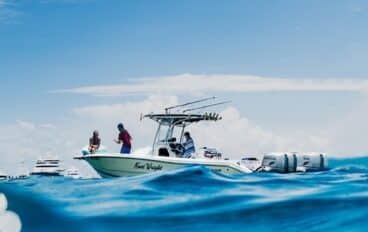
5 Best Portable Fish Finder in 2023
Looking for a portable fish finder for kayaking, ice fishing, or other activities? The good news is that there are a lot of solid products out there. The year 2023 has ushered in an array of advanced models, each brimming…
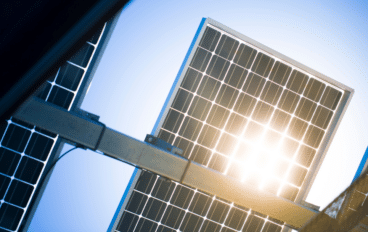
Charging Your Trolling Motor Battery with a Solar Panel
Charging your trolling motor battery with a solar panel is not just the right thing to do for the environment, it is extremely convenient. When you’re out on the boat, with any luck, you’ll have access to a good amount…
Don't miss out
Yachting Monthly
- Digital edition

Electric winches: a buyer’s guide
- Sam Fortescue
- March 9, 2022
Electric winches are becoming cheaper and simpler to fit, making effortless sailing an affordable option, says Sam Fortescue

Converting to push-button powered electric winches is easier than you might think
Electric winches have been with us for decades, and are often specced as upgrades on cruising boats. But as the idea of all electric yachts becomes more prevalent and battery performance improves, electric winches are also fast becoming more comonplace.
The technology behind it is pretty unimpeachable these days, but manufacturers are always finding small incremental improvements to distinguish their product from the competition.
Take major supplier Lewmar, now part of the US Lippert Group. Its sleek Evo winch, which weighs 20% less than the familiar Ocean range, is available in a fully electric version from size 40 upwards.
And so is its Revo range – designed to backwind so that you can sheet out at the touch of a button too.
Though touted as a racing feature, this is exceedingly useful for shorthanded crew or solo sailors, where it might otherwise mean letting go of the helm to dive into the cockpit and manually slip a line.
An electric Evo 40ST costs from around £2,810, while the Revo version is priced according to exact requirements.

You can use handles in electric winches, but the technology is very reliable. Credit: Mike Turner
An upgrade even allows you to connect two electric winches together, so that one backwinds while the other takes in the slack when tacking – at the touch of a single button.
‘We would not generally sell the Revo winch system to an aftermarket customer, as they require very specific set-up requirements,’ says Claire Martin, group marketing manager at Lippert.
Harken is often considered a step up from Lewmar, with racing pretensions.
Here, too, the basics are well covered with a range of instantly recognisable black anodised self-tailers (bronze and chrome finishes are also possible).
Electric versions start at size 35, and cost from around £2,586.
And the Harken Rewind Radial is also able to backwind at the touch of a button, like the Lewmar Revo.
It goes a step further in that a knob on the winch itself allows you to switch between forward-reverse mode and two-speed winding in one direction.

The Selden E40i has an internal motor. Credit: Selden
This feature kicks in from size 40, costing from £4,168.
Antal is another strong winch brand with a stout electric option in the XT.
You’ll need the control box that houses the solenoids, and should consider the additional load control box, called the WBC.
This starts the winch in its fast gear, then steps down to the more powerful slower speed when the winch reaches its maximum safe working current.
It cuts out altogether when it hits this limit in slow gear. At £3,220.87 for the winch plus more for the WBC, this is not a cheap option.
If there’s a limit to Lewmar, Harken and Antal’s otherwise well-engineered and soundly priced systems, it is the choice of control buttons available.
Continues below…

Step-by-step guide to servicing winches
Some sailors expect their winches to work year after year with little or no maintenance. Mark Corke offers a step-by-step…

How to service a winch: an expert’s guide
How to service a winch and keep it running smoothly

Mainsail furling systems: an expert guide
Some sailors swear by mainsail furling systems, others swear at them. Graham Snook looks at way to keep your furling…

Electric anchor windlasses: a guide to the latest tech
Electric anchor windlasses are becoming more affordable and can take the grind out of cruising shorthanded, says Sam Fortescue
There are just two options, both for deck mounting, which have a housing that allows them to be activated with a finger when closed, or by a foot when open.
It doesn’t allow you to put a button on the instrument console or wire it into a digital switching system.
Denmark’s Andersen is reputed for the quality of the build of its all-stainless steel winches, which run from size 12 up to 110.
The E1 is its entry-level electric winch, which operates with just a single speed.
Two- and even three-speed versions start from the 60ST size, which roughly equates to genoa sheeting on a 45ft-plus boat.

The Harken Performa winches are available with manual, electric or hydraulic drives. Credit: Harken
A super-simplified Compact Motor system is available, where all the gubbins from gearbox to controller is built into a single, low-profile unit.
‘It uses a brushless DC motor matched to a low profile planetary gearbox, which requires less space for installation and draws considerably less current than traditional motor/gearbox configurations,’ explains Andersen’s Thomas Galster.
‘Simple electrical installation requires no external control box, and the low profile above or below deck motor allows installation even if the original boat design did not allow for space under the deck for a motor.’
Another nice feature of the Compact Motor is the variable speed system, where a pressure-sensing button controls the rate of rotation: the harder you press the button, the faster the winch will turn.
Pricing for the Compact Motor starts at around £2,250 for the 28ST unit, and £2,940 for an E1 of the same size.
A relatively slim plastic or stainless-steel hinged lid protects the button, which is designed with a built-in LED which tells you when the system is powered up.
Electric winches: connectivity
When it comes to connectivity, however, Selden is streets ahead with the launch of its E40i electric winch (£2,850).
This is unique in its ability to talk to other Selden devices in a push-button system that might include a furling main or headsail.
It uses its own bus network to shuttle information between units and in principle, just a single power supply unit (£592) is required to run all the components.
It is not yet compatible with a multifunction display (MFD) or your NMEA instrument network, but that is surely just a question of time.
The motors involved all run on 42V, which has several benefits over 12V or 24V without running into the restrictions associated with ‘high-voltage’ equipment over 50V.

Electric winches can make sailing shorthanded a lot easier. Credit: Selden/Dan Ljungsvik
This higher voltage means lower amperage during power-intensive use, so wiring runs can be lighter and motors smaller.
This has allowed Selden to engineer a powerful motor that actually fits inside the drum of the E40i winch, so there’s no heavy-duty drilling required to install, fitting on deck exactly as a manual winch does.
Launched last year in Sweden, the E40i has proved popular with boat owners in the 35-45ft range, especially those who sail with limited or inexperienced crew.
‘It’s convenient and easy for everyone onboard, such a simple way to hoist, furl and trim the sails,’ says Anders Lagerberg, owner of a Najad 400 with an E40i installed.
‘I’m experiencing much smoother sailing than ever before, especially when sailing by myself.’

Anderson’s electric winches are all stainless steel. Credit: Anderson
Six years ago, Jeanneau teamed up with Harken to launch the ultimate in connected winches.
A Harken Rewind was linked to a dedicated sail handling display to automatically trim sails without the skipper having to raise a finger.
It could handle wind shifts, gusts and course changes, and even to tack the jib.
Jeanneau had expected 20% of those buying its 50-plus foot boats to opt for the €15,000 system, but it appears to be no longer available, which tells its own story.
Electric winches: main brands

Credit: Lewmar
The Ocean and Evo (above) winches can be electric but conversion kits for manual are also available.
www.lewmar.com

Credit: Harken
Harken’s motor drives the central shaft, using the winch’s gears, rather than driving the drum directly, so reducing the power draw.
www.harken.com

Credit: Antal
Antal says its winches deliver 490W or 700W at the winch drum, compared to a human arm at 400W.
www.antal.it

Credit: Anderson
Andersen winches are distinguished by the use of a ribbed drum surface, which doesn’t abrade ropes like the commonly used rough finish.
www.andersenwinches.com

The E40i’s internal motor means that there’s no big hole in the deck, and no motor protruding into the space below.
www.seldenmast.com
Enjoyed reading this?
A subscription to Yachting Monthly magazine costs around 40% less than the cover price .
Print and digital editions are available through Magazines Direct – where you can also find the latest deals .
YM is packed with information to help you get the most from your time on the water.
- Take your seamanship to the next level with tips, advice and skills from our experts
- Impartial in-depth reviews of the latest yachts and equipment
- Cruising guides to help you reach those dream destinations
Follow us on Facebook , Twitter and Instagram.
Practical Boat Owner
- Digital edition
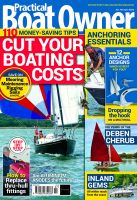
Electric winches, handles and furlers – a buyer’s guide
- March 14, 2020
From the cockpit to the pulpit, there are Electric winches, handles and furlers on the market that can help take the strain out of sailing. Duncan Kent reports

Maybe you want to spend more time sailing single-handed, or perhaps you’re reaching the age when winching up the mainsail by hand is starting to take the fun out of a weekend sail. Whichever it is, why not accept a helping hand from Mr Volt?
The best Lithium-ion battery for your boat – we test 12 units
Kitting out a sailing boat with electric winches and furlers may look to be expensive, but if it keeps you on the water isn’t it worth it? In fact quite a few sailors end up moving over from sail to power because they no longer have the physical strength to manually winch in the sheets or haul on the halyards. But the extra cost often works out at considerably more than if they had invested in simply upgrading their sailing yacht.
For instance, a good many manual winches can be electrified by buying a conversion kit (Lewmar, Harken and Andersen all sell manual-electric upgrade kits for their two-speed winches), which often works out costing half the price of a new winch – especially if you’re good with the DIY and can modify the drive unit, and install the electrics yourself. The latter is easier than you may think as all the components are supplied, along with full instructions and an easy-to-understand circuit diagram.

Andersen electric winch
To keep costs down people often just convert one halyard winch, usually on the side of the mainsail halyard. Then, with a bit of clever rerouting of the genoa sheets via one or two new turning blocks, you can often use the same winch for hauling in the bulk of the genoa. This is a fantastic help if, like me, you have a huge overlapping genoa. If you’re feeling a little flush, why not convert one of the primary winches too?
In fact, I’ve sailed on a boat that had one electric primary, to starboard, that could be used haul up the halyards and take in the port genoa sheet simply by taking one turn around the manual winch and then leading the sheet or halyard onto the powered one. This way, once the bulk of the sheet/halyard has been hauled in, it’s easy enough to take another couple of turns around the non-powered winch ready for manual trimming if necessary.
Depending on your boat’s layout, you may want to install a second deck switch so you have a clear view of the headsail on both tacks. The owner had even set it up so he could electrically winch the kedge anchor from the stern – essential when mooring bows-to in a Mediterranean harbour to protect the rudder or for privacy in the cockpit.

Comparison table: electric winches
Reduce friction
In a similar way to reducing your power consumption before planning a new electrical system, it makes good sense to look at reducing the friction in your sail control systems before considering how best to assist you with the hard graft of winching and hauling.
Boats older than 20 years will probably have outdated blocks with plain bearings, as will many of the newer, lower cost production boats. Just spending a few hundred pounds replacing blocks and travellers with ball-bearing versions can reduce frictional loads by up to 40 per cent. Now ally this with a little thought into how you can reroute lines so as to diminish the angle of turn and maybe even take a turn out altogether where possible, and you could find you need half the elbow grease you did previously to hoist the main or sheet in a genoa.
Then there’s the sail plan. Changing to a non-overlapping jib will noticeably reduce the effort required when tacking and you can still save the big genoa for when your kids join you. Besides, with a well-cut jib you’ll lose little speed to windward in a good breeze and if you add a furling asymmetric downwind sail you’ll notice little difference on a reach too.
Modern yachts frequently sport non-overlapping jibs and sometimes even self-tailing headsails, but this usually means the mainsail is bigger to compensate, thereby increasing the effort required to hoist it in the first place.
Reefing can also be exhausting, particularly if you have a single-line reefing system, as they create a lot of friction due to the reefing lines turning around multiple blocks. If you can, use a two-line system – one line for the luff and another for the leech. Okay, it’ll mean a little more string, but it’ll need far less winching effort to drop in a neat reef.
Lastly, regular maintenance of deck gear is essential. If you don’t service your winches every year, not only will they eventually fail, but also the amount of effort required to operate them will increase until half of your hard work is wasted in turning the winch rather than doing the job. The same goes for electric winches – the increased friction will simply decrease your battery power more rapidly and you risk the circuit breaker cutting out just when you don’t want it to, should it become overloaded.
Keep a close eye on any deck switches, too. After a while water can penetrate their seals and if one of these goes faulty there’s a danger the winch or windlass might remain on – possibly with disastrous consequences.
Powered winch handles
Before you start planning to upgrade your manual winches to electric, consider the possibilities of buying a powered winch handle instead. Like everything there are pros and cons of course – as with most bits of boat kit – but we have had many boat owners writing to us to say that they’ve only been able to continue sailing thanks to one of these devices to help them on board.
First, the cons: they’re not particularly cheap, they need charging regularly and they can be lost overboard if the user is careless or loses their balance. Furthermore, if you’re sailing singlehanded it will be much easier and safer if you have self-tailing winches in order to keep both hands on the electric winch handle, as there will be a fair amount of rotational torque once the power really comes on.
The pros: they will effectively electrify every standard top-drive winch on board (although obviously only one at a time) and they don’t require you to modify your boat or install heavy-duty power cables as you would need to when fitting an electric winch.

Winchrite powered winch handle
The most popular is the Winchrite (£599), now in its second generation with more power thanks to a greatly improved motor and gearbox and extended charge duration. Yes it’s still a little noisy, but then so is any electric winch. Being low-geared for maximum power, they’re a bit slow (120rpm), so you might still prefer to pull the bulk of the sheet in by hand before letting the Winchrite take over. It also needs a steady grip to keep it from rotating when under a heavy load.
A recently launched ‘power assist’ winch handle called the ewincher is a little less bulky and lighter than the Winchrite and, better still, has two-speeds, making it more suitable for hauling in and trimming headsail sheets without needing to resort to hauling the bulk of it in by hand.
Shaped more like a traditional winch handle, the ewincher allows the user to winch manually as normal, but then assists when the load really comes on. Alternatively, it can be used purely as an electric winch handle, like the Winchrite. The good news is the 24V battery pack is removable, as with all modern cordless power tools, so you could have a second, back-up power pack sitting on the charger ready for a quick swap out. The bad news is it currently costs close to £2,700, so you really wouldn’t want to drop it overboard!

Milwaukee 8 drill
Another alternative is to use a right-angle cordless power drill, although it would need to be very powerful. A popular model is the 28-Volt Milwaukee drill, which has a 16in (40cm) long handle and is available on eBay for around £400, including a single 28V lithium-ion rechargeable battery. You can even buy a purpose-made, 8-point ‘winch-bit’ or Cranker chuck replacement for this and other 0.5in (12mm) chuck drills. Spare battery packs and a padded cover are also available, but it only has a 220V AC charger so it can only be recharged underway using an inverter.
A note of warning – both the electric winch and the powered winch handle manufacturers strongly advise you not to use any of these devices for hoisting a crewmember up the mast. This is because they have been known to fail and endanger the lives of the crew being hoisted and others below. I, too, wouldn’t condone this practice for my own reasons, but in reality many do use them for just this purpose. If they’re sensible they take additional precautions, such as not relying on self-tailing winch jaws to take the strain and attaching a second halyard with someone else other than the wincher taking up the slack and belaying it between hauls. Having another person standing by at the main power switch in case it gets stuck on is also a good plan.
Of course, the usual point of not using an external halyard to go aloft counts for both manual and powered winches. If a sheave or bearing breaks on an internal halyard at least you’re not going to plummet to the deck!
Electric furlers

Loop eFurler
In truth, headsail furlers on small to medium-sized sailing yachts shouldn’t ever need winching – manually or electrically. If they do then something is usually wrong. Either the swivel bearings are salted up or dried out, the halyard has been hoisted up too hard, or you have halyard twist at the top swivel.
But for those that simply want to ease the amount of physical work involved in sailing, there’s no reason why you can’t fit an electric furler, or an electric winch that the furling line can reach.
Code 0 and asymmetric spinnaker furlers usually have continuous loop furling lines that can require a crewmember to leave the cockpit.
However, since the advent of small but powerful Lithium-ion battery packs other solutions have been developed. The new, German-made Loop EF1500 E-Furler uses a small 18V Li-ion battery pack to drive an electric furler, designed so that it is all neatly contained within the bowsprit pole itself. It comes with a wireless remote control so the sail can be furled and unfurled from the cockpit and a spare battery can be kept in an onboard charger ready for a quick swap out if necessary.
Anchor windlass

Lewmar V1 electric windlass
Cruising sailors, both power and sail, have long been aware of the delights of an electric anchor windlass and since the development of the rope/chain combination gypsy, the whole process of lowering and raising the anchor can be automated by remote control from the cockpit.
Once again the least expensive way to take the strain out of anchor hauling is to find a mechanical windlass that can accept a standard winch handle and then buy something like the Winchrite to operate it. This saves on the expensive and heavy wiring necessary for a permanent electric windlass and doesn’t put so much load on your house batteries.

Windlass comparison table
Power considerations
Whatever way you decide to electrically ‘assist’ your sailing you’ll need to consider the effect on your boat’s electrical energy reserves. An electric winch or windlass draws a serious amount of power when operating, some 80-150A, so make sure your battery banks and circuit protection can cope with this.
While adding an additional battery to the service bank is easy, keeping it fully charged is less so. Boats that have more than one deep-cycle battery need a proper charging regime – usually in the form of a smart alternator regulator and/or more powerful alternator.
But along with more Amps going in and out comes the need for better monitoring and overload control, with careful thought given to the safety of the electrical system. Using wires that are too small in diameter not only lowers the voltage available to the device, but also increases the risk of fire on board should any of the wires overheat.

Ex-Display & Sample Sale
- Search for:
No products in the basket.
- Base Layers
- Technical T-Shirts
- Sailing Jackets
- Sailing Trousers
- Dinghy Footwear
- Sweatshirts
- Holebrook Samples
- Pelle Samples
- Changing Robes
- Cleaners & Proofers
- Scarves / Snood
- Dinghy Equipment
- Hi-fits / Trousers
- Hiking Equipment
- Hiking Shorts
- Spray Tops / Smocks
- Full Wetsuits
- Shorty Wetsuits
- Long John Wetsuits
- Wetsuit Tops
- Wetsuit Shorts & Trousers
- Summer Wetsuits
- Winter Wetsuits
- Children’s Wetsuits
- Men’s Wetsuits
- Women's Wetsuits
- Wetsuit Sale
- Technical Clothing
- Casual Clothing
- Hats, Gloves, Socks & Scarves
- Watersports
- Accessories Sale
- Garmin Special Offers
- Amazing Bundle Deals
- Cables & Accessories
- Fixed GPS/plotters
- GPS Antennas
- Handheld GPS/Plotters
- Marine Cameras
- Mounting/Brackets
- Radar Scanners
- Sailing Watches
- Thermal Cameras
- Waterproof Cases
- Accessories
- Fish Finder Sonar
- Depth Instruments
- Multifunction Systems
- Speed Instruments
- Weather Instruments
- Wind Instruments
- Autopilot Accessories
- Cockpit Autopilots
- Onboard Autopilots
- Navigation Charts
- Plotting Aids
- Entertainment Accessories
- Entertainment Systems
- Speakers & Subs
- Electronics
- 4G and WIFI
- Handheld VHF Radio
- Mounted VHF Radio
- VHF Antennas
- Walkie Talkies
- Buoyancy Aids
- Lifejackets
- Children’s Life Jackets
- Commercial Lifejackets
- Harnesses/Bosuns Chair
- Lifejacket Accessories
- Safety Knives
- Safety Lights
- Safety Lines
- PLB & AIS
- Satellite Communicators
- Fire Safety Stick
- Fire Extinguishers
- GPS Tracker
- Liferaft Accessories
- Recovery Devices
- Survival Suit
- Cones & Balls
- Dye Markers
- Horns & Whistles
- RADAR Reflectors
- Bungs & Bailers
- Battery Management
- Chargers & Alternators
- Electrical Other
- Leisure Batteries
- Plugs & Connectors
- Shore Power
- Wind Generator
- USB & Phone Chargers
- Blocks & Terminals
- Circuit Breakers
- Seals / Outlets / Plugs
- Switches & Panels
- Wires & Cables
- Deck Lights
- Interior Lighting
- Navigation Lights
- Searchlights
- Head Torches
- Freshwater Pumps
- Macerator Pumps
- Service Kits
- Toilets/Waste
- Spray Guns & Connectors
- Toilet Accessories
- Toilet Parts
- Waste Tanks
- Ball Valves
- Inlet & Skin Fittings
- Metal Plumbing Fittings
- Plastic Plumbing Fittings
- Diverter Valves
- Non Return Valves
- Deionised Water
- Filters & Purification
- Taps & Sinks
- Water Heaters
- Water Tanks
- Gas Connectors
- Gas Fittings
- Bow Thruster
- Bungs And Self Bailers
- Cleats and Fairleads
- Deck Filler
- Deck Flooring & Protection
- Eye Bolts & U Bolts
- Grab Rail / Handles
- Hooks and Clips
- Latches & Catches
- Shackles & Swivels
- Tiller Extenders & Joints
- Track & Cars
- Winch Handles
- Fans & Windscoops
- Hatch & Inspection Covers
- Hatch Shades
- Hatches & Portlights
- Plastic Hatches
- Yacht / Keelboat Rope
- Dinghy Rope
- Dockline / Mooring Rope
- General Purpose Rope
- Watersports Rope
- Fender Rope
- Rope Accessories
- Furling & Reefing
- Mast, Spars & Sails
- Pins & Rings
- Rigging Screws, Adjusters & Tensioners
- Splicing & Whipping
- Thimbles & Stoppers
- Galvanising Paints
- Thinners & Solvents
- Paint Brushes
- Glue & Adhesives
- Mixing Pots & Accessories
- Resins & Epoxy
- Sealants & Caulking
- Boat Cleaner
- Cleaning Equipment
- Fabric Cleaners & Proofers
- General Cleaners
- Metal Cleaners
- Onboard Cleaner
- Polishes & Waxes
- Vinyl Cleaner
- Teak Cleaner
- All Zinc Anodes
- Zinc Shaft / Prop
- Zinc Engine / Outdrive
- All Aluminium Anodes
- Aluminium Hull
- Aluminium Shaft / Prop
- Aluminium Engine / Outdrive
- All Magnesium Anodes
- Magnesium Hull
- Magnesium Shaft / Prop
- Magnesium Engine / Outdrive
- Bow Thruster Anodes
- Hanging Anodes
- Bolts & Fixings
- Backing Pads
- Lubricants & Grease
- Power Tools
- Marine Prepacks
- Dehumidifiers
- Blowers & Exhaust
- Engine Oil & Additives
- Oil Extractors & Filters
- Shaft Bearings
- Pumps & Inflation
- Tender Accessories
- Petrol Engines
- Boat Fender
- Dock Fender
- Edging Strip
- Hooks & Pumps
- Mooring Buoy
- Step Fenders
- Anchor Bags
- Anchor Connectors
- Anchor Lines
- Anchor Windlass
- Compensators
- Personal Craft
- Engine Covers
- Fuel Tanks & Lines
- Kill Switches
- Propeller Bags
- Straps & Ratchets
- Flag Staff & Holder
- Lighters & Matches
- Cabinet Fridges
- Cooling Kits
- Portable Fridge/freezers
- Chandlery Misc
- Cup Holders
- Sail Knives
- Seats & Cushions
- Games & Toys
- Gift Vouchers
- Nautical Gifts
- Novelty Hats
- Anemometers
- Clocks & Barometers
- Teak Fittings
- Weather Stations
- Galley Equipment
- Tumblers & Glasses
- Water Bottles & Flask
- Inflatable Paddleboards
- Hard Paddleboards
- Inflatable Kayaks
- Handles / Bridles
- Throw Lines
- Swim Accessories
- Sea Scooter
- Free Delivery on UK mainland orders over £100 excl. Highlands / rural areas
At Marine Super Store we’ve got a wide selection of windlasses from Lofrans and Lewmar. Find vertical and horizontal windlasses and windlass accessories at the best prices and enjoy free UK mainland delivery* when you spend over £100.
Showing 1–36 of 55 results

Lewmar Pro Series Windlass 1000 12v 8mm + Remote
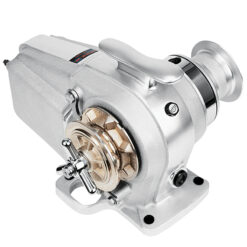
Lofrans Tigres 1500 12v Windlass

Lofrans Cayman Horizontal Windlass

Lofrans Kobra Windlass
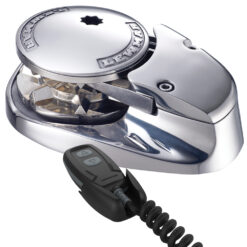
Lewmar V700 Vertical Windlass 12v + Remote
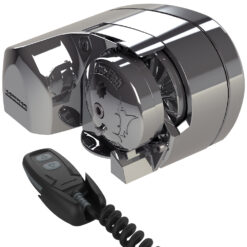
Lewmar Profish Windlass 1000 12v 8mm + Remote

Lofrans Royal Windlass

Lofrans Tigres 10mm 24v Windlass
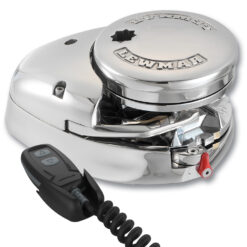
Lewmar V1 Windlass 8mm 12v + Remote

Lewmar VX2+ Gypsy Drum 8mm Gypsy 12V Extended Kit + Remote
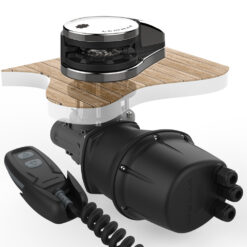
Lewmar VX2+ Gypsy 10mm ISO 12V 1000w + Remote
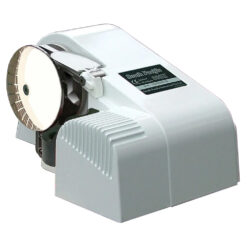
South Pacific Horizontal Windlass 700W
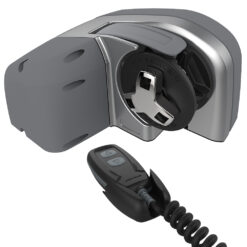
Lewmar HX1 Go 800 Windlass Kit 8mm + Remote

Lewmar VX1 Vertical Windlass 6/7mm 500w + Remote
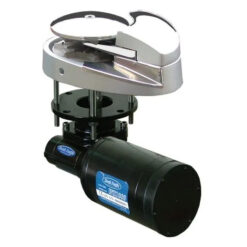
South Pacific 8mm 1100w Vertical Windlass
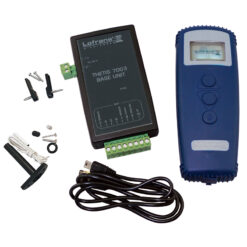
Lofrans Radio Control Chaincounter

Lewmar Wired Windlass Remote Kit
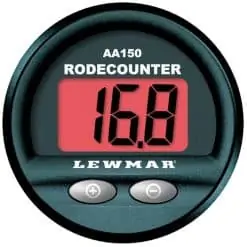
Lewmar Chain Counter AA150 Plug/Play

Lofrans Handheld Remote Control 1002

Lofrans Handheld Remote Control Chaincounter Thetis 5003

Lofrans Mini Remote Control 4 Buttons and Receiver
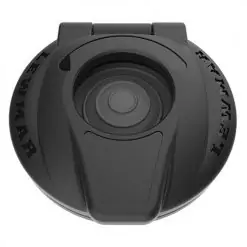
Lewmar CHSX Electric Deck Switch Open Lid
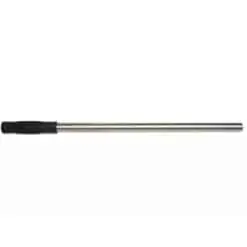
Lofrans Tigres Handle
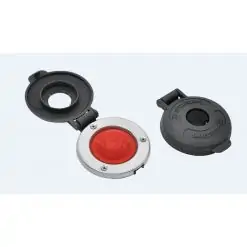
Lofrans Foot Switch

Quick Anchor Foot Switches
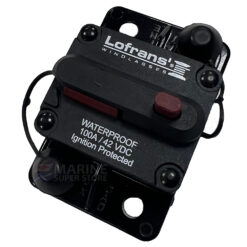
Lofrans Thermal Circuit Breaker
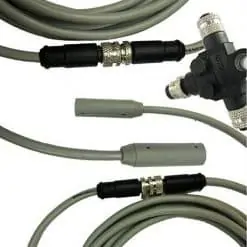
Lewmar AA Sensor Cable With Plugs 6.5m
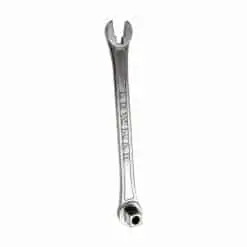
Lewmar Windlass Clutch Lever

Lewmar Manual Recovery Pawl Kit

Lewmar Windlass Magnet And Sensor Kit
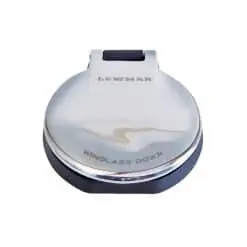
Lewmar Stainless Steel Footswitch Down
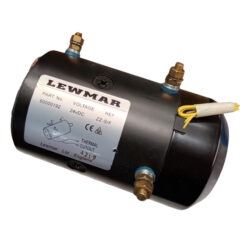
Lewmar 24v 2000w Motor Spare – 60000192SPA
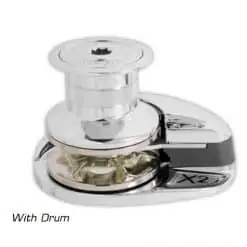
Lofrans X2 Windlass

Lewmar VX2+ Gypsy 8mm 12V 1000W + Remote

Lewmar CHSX Stainless Steel Closed Deck Switch
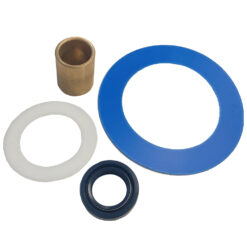
Lewmar V Service Kit
Privacy Overview
Username or email address *
Password *
Remember me Log in
Lost your password?
Email address *
A password will be sent to your email address.
Posted 2024-05-19 17:23
Contact Information:
Boat trailer w/ electric winch - $1,500 (Port Townsend)

google map
more ads by this user
QR Code Link to This Post
post id: 7748640898
posted: 2024-05-19 17:23
♥ best of [ ? ]
refresh the page.
Boat trailer w/ electric winch - boat parts - by owner - marine sale...
Trailer came with my boat and I have no need to keep it. New tires, new tabs. Custom electric winch for mast stepping or hauling out. Easy on/off. Came under a 19' sailboat but could hold a boat a...

IMAGES
VIDEO
COMMENTS
Gypsy. A small but very important part of choosing the right windlass is to ensure it will work with your anchor rode. The rotating part of the windlass is known as the gypsy and will be designed for an exact chain size. Many are capable of automatically handling a rope-chain rode.
An electric anchor windlass should be able to pull four times the weight of the chain and the anchor combined. On heavy displacement boats or for bluewater peace-of-mind, look for an extra safety factor to account for getting the boat moving. Some electric windlasses can be integrated with your boat's existing instruments so you can monitor ...
Refit a Classic Yacht with an Electric Windlass. For active cruisers, refitting a classic plastic sailboat with an electric windlass can help take the (back) pain out of anchoring. By David Schmidt. March 16, 2022. During Boat of the Year testing, anchor systems are carefully inspected because they're critical to cruisers. Jon Whittle.
That is, a 33' boat with a 22lb. Delta anchor, 200' of 1/2" rope with 15' of 1/4" chain and a shackle (about 40lb.), with a total ground tackle weight of 62lb., would select a windlass with at least 248lb. of pull (62lb. of ground tackle, times four). If ground tackle is too heavy or close to the windlass's maximum pulling power, or if the ...
Lewmar Windlasses. At Lewmar, we think about what makes boaters' lives easier, and bring those ideas to life in our products. ... Electric Winch (4) Hydraulic Winch (1) REVO® Winch (2) Winch Handle (1) ... Boat length. 101+ ft (26) 31-50ft (48) 51-70ft (35) 71-100ft (28) up to 30ft (48) View Details. VX1 Vertical Windlass. View Details. RX ...
4. Five Oceans Horizontal Anchor Windlass. Thanks to its pretty powerful 600W motor, this windlass can reach a maximum pulling power of 1200 lbs and a maximum line speed of 115 feet per minute. You can use this item with a range of rope types, namely three-strands, double - braided and eight-plate ones.
It is suitable for boats to 38 feet in length. 1. Mounting of the Windlass. Select a mounting location on the bow that allows the rode to drop directly into the anchor locker and also puts the gypsy in a straight line with the anchor roller. The minimum anchor-locker depth is 12 inches to the top of the rode pile.
Sizing Considerations: The anchor windlass is intended to retrieve the anchor and ground tackle, not to pull or drag the boat. A typical rule of thumb is to take the total weight of the anchor and ground tackle and multiply by a factor of three. (for example a boat with a 22lb anchor and 40lbs of anchor rode and hardware would select a windlass ...
Windlasses. Electric Windlasses for anchoring are standard equipment for most new sailing yachts and motorboats. Upgrades on older yachts are increasingly popular with the advent of improved DC electric charging systems and the tendency towards longer lengths of anchor chain. The Jimmy Green Team can advise you on all the options regarding your ...
Lofrans Project 1000 Vertical Windlass - Low Profile - 12v Motor 1000W Electric Anchor Windlass LW7921LP. The Lofrans Project 1000 series boat windlasses are engineered to endure any marine environment a yacht or sailboat may traverse. Each part is manufactured with importance placed on light weight, high mechanical strength, and corrosion ...
The Lewmar H3 Electric Windlass is recommended for boats measuring 30 to 40 feet LOA. The Simpson-Lawrence Legacy. When Simpson Lawrence sold out to Lewmar in 2000, one of the most lamentable casualties of the transaction was the complete closure of the Simpson Lawrence line of manual windlasses. However, parts for the 510, 555 and Anchorman ...
An electric anchor windlass is a standard piece of gear on a power voyaging yacht. One of its great advantages — other than pulling up the anchor for you — is that it requires practically no periodic maintenance other than an occasional fresh water rinse, and in the longer term, an oil change. But even
Making the right windlass anchor choice will ensure many successful seasons of secure anchoring. You can also always rely on Wholesale Marine to stock the right parts at affordable prices. Be sure to contact us if you have questions about windlass anchors or if you need to place an order. We're available at (877) 388-262, Monday through ...
Minn Kota Anchor Winch. The Minn Kota Pontoon Deckhand is hands down one of the best electric anchor winches. This winch is rated for a 40lb anchor. That means you want to scale back to at least 35lbs. Lower is fine as well. Remember, the reason for this is to ensure your winch lasts as long as it can.
Shop the best selection of Anchor Windlasses from West Marine. Visit for products, prices, deals and more! Enter Zip Code ×. Use my ... DeckHand DH 40 Electric Anchor Winch V700 Vertical Windlass Replacement Motor Kit VWC Series Windlasses H2 Gypsy/Drum Heavy Duty Windlass ...
Easy to install. The wiring may not be long enough. It is hard to go wrong with a Trac boat anchor winch. The Trac Outdoors Deckboat 40 AutoDeploy-G3 Electric Anchor Winch is similar to the product above, but it has a 40-pound capacity rather than a 20-pound capacity, making it suitable for larger boats and anchors.
Buy Electric Anchor Winch,Marine Anchor Winch Saltwater Boat Anchor Windlass Kit with Wireless Remote Control,Anchors Up to 45 LBS, Heavy Duty Towing Winches for Fishing Boat Pontoon Boat (45LBS, Black): Winches - Amazon.com FREE DELIVERY possible on eligible purchases
Denmark's Andersen is reputed for the quality of the build of its all-stainless steel winches, which run from size 12 up to 110. The E1 is its entry-level electric winch, which operates with just a single speed. Two- and even three-speed versions start from the 60ST size, which roughly equates to genoa sheeting on a 45ft-plus boat.
As with any piece of marine or electrical equipment, anchor windlasses sometimes fail. Luckily, windlass failures are very rarely catastrophic, and the issue can often be diagnosed and repaired simply. This article will go through the common issues that can arise with an anchor windlass, and then how to diagnose and resolve them. Issue #1: Your Electric Anchor Windlass Won't Run in Either ...
Winchrite powered winch handle. The most popular is the Winchrite (£599), now in its second generation with more power thanks to a greatly improved motor and gearbox and extended charge duration. Yes it's still a little noisy, but then so is any electric winch. Being low-geared for maximum power, they're a bit slow (120rpm), so you might ...
Electric Boat Winch, Reversible Electric Trailer Winch 12V, Power-in, Power-Out and Freewheel Operations, Portable Winch Boat Trailer Truck Boats 2000 lbs w/Remote Control Hand Crank for Cars Yachts. $99.99 $ 99. 99. List: $119.99 $119.99. $35 delivery May 21 - 28 . Only 20 left in stock - order soon.
Lewmar VX1 Vertical Windlass 6/7mm 500w + Remote. £ 1,116.47 £ 849.95. South Pacific 8mm 1100w Vertical Windlass. £ 799.95 £ 669.95. South Pacific Horizontal 8mm - 1100W Windlass. £ 799.95 £ 629.99. Lofrans Radio Control Chaincounter. £ 359.99 £ 299.95. Lofrans Royal Windlass.
Boat Electric Anchor Winch, 12V Heavy Duty Towing Winches,Marine Anchor Winch Saltwater Boat Anchor Windlass Kit with Wireless Remote Control, Anchors Up to 25 LBS,for Fishing Boat Pontoon Boat,Black. $149.99 $ 149. 99. $50 delivery May 22 - 28 . Powerwinch RC 30 Wireless Remote Trailer Winch.
Boat trailer w/ electric winch - $1,500 (Port Townsend) ... New tires, new tabs. Custom electric winch for mast stepping or hauling out. Easy on/off. Came under a 19' sailboat but could hold a boat a bit longer. post id: 7748640898. posted: 2024-05-19 17:23. ♥ best of .